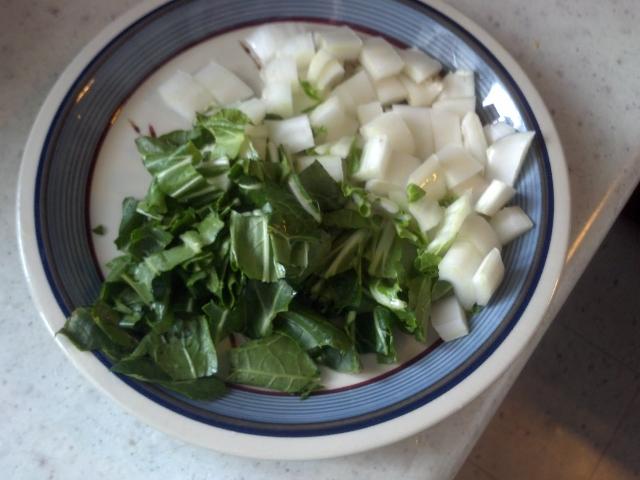
For 46 days, I'm trying to spend less than $2.50 a day on food. This is an account of the food, the costs, the science, and the fun of that experiment.
I love food and I love to cook. I love to study the science of cooking. I'm very lucky—I'm not in a position that I have to strongly limit my food expenses, but I have always wanted to see how well I could cook and eat on a limited budget. It would encourage me to think about new ingredients, new techniques, and new dishes. I love cooking competition shows like Iron Chef, and enjoy cooking with limited ingredients, or cooking with a lot of a specific ingredient that someone dumps in my lap.
Okay, that's only part of my inspiration. I used to have a huge box of Richie Rich comic books that I bought from my friend for $3. In case you're not familiar with all of the employees of the Rich family, their chef was Chef Pierre, the world's greatest chef. One time, Chef Pierre was kidnapped and held by a bunch of criminals. The criminals told Chef Pierre that he had to cook for them—but they only had potato chips and ketchup!. Not a problem for the world's greatest chef! He created food that was so delicious that the criminals quickly got fat—so fat that they couldn't get through the entrance to their hideout! Chef Pierre then escaped by simply walking out unchallenged! (After which, Mr. Rich's security force swept in and cut all the criminals' heads off.)
In any case, I always wanted to be that good, and be that versatile with ingredients: so good that I could make a good meal out of whatever's on hand. I'd love to be on a cooking challenge show, and see how well I could do with constraints and surprises, and with limited ingredients (like whatever's on a great sale, or your neighbor drops on your doorstep.) I consider this my preparation.
It seemed like a fairly challenging target; enough so that I'd have to think harder and perhaps learn more. When I started this challenge for the first time in 2014, a friend of mine noted that in nursing school, they were challenged to eat on $5/day. (And record their nutrition and caloric intake.) I estimated some of my meal costs, and decided that $2.50/day would be challenging, but safe and still fun.
I encourage you to try challenging yourself to make meals for whatever price you care to choose, for whatever duration you choose, whether it's for 45 days, or once a week, or whatever. Please let me know what you do, either by email at eliasen@mindspring.com or on Twitter at @aeliasen. I'll share good recipes and recommendations on here. Also, share food with others and donate to your local food banks!
I've set some rules and guidelines for myself to follow:
The first day, not coincidentally, coincided with Ash Wednesday, the first day of Lent. Since that's typically a date of fasting, I'm having a single meal. But one of my favorites—good old Campbell's tomato soup and a couple of toasted cheese sandwiches! And they were proper toasted cheese sandwiches. Butter the bread on the outsides, fill them with good cheese, and cook them in an electric frying pan at 350 °F for a couple minutes on each side.
I forgot to take pictures, but you know what a toasted-cheese sandwich and tomato soup looks like.
I'm not always going to remember to measure and weigh my ingredients, but I did today, so I'll describe the process briefly. A digital kitchen scale is very very useful for many types of cooking.
I like my tomato soup made with milk, so I added 1 can of milk. Now, a digression:
A quick digression: Ounces (and pounds and kilograms) are a unit of mass. "Fluid ounces" (also written fl.oz.) are a unit of volume. Don't confuse them.
The labels on liquids and semi-liquids (like mayonnaise) is usually indicated in fluid ounces (volume.) The labels on solids and canned goods is usually labeled in ounces (mass.)
(By the way, if you think that a pound or an ounce is a unit of weight, and not mass, that's a common (but potentially dangerous) misconception. Read the full discussion of this in this Frink FAQ entry.)
Okay, back to the topic. I buy my milk by the gallon (volume) but the can of soup is marked by the mass it contains. I wanted to measure the volume of the can. The easiest way to do that, using just a scale, is to weigh the can filled with water, and then weigh the can empty and subtract the weights. This gives you the weight of water that filled the can. Fortunately, our units of mass and volume are calibrated around water.
The following are all basically equivalent statements:
These rules make it easy. The can, filled with water, was 10.7 ounces heavier than the empty can, so it contained 10.7 fluid ounces of water. Since a gallon of milk cost $2.99, the total milk cost was $0.25.
I used up the last of a bit of fancy yummy shredded Tillamook Italian 3-cheese (mozzarella, smoked Provolone and Parmesan!) that I still had open, so the cheese price was higher than some cheaper cheese that I bought later. (Again, no waste!) We'll call it $6 / lb. But how do you weigh shredded cheese? You can't weigh the cheese first and then put it on the sandwich, because how will you know how much you're going to need? I weighed the cheese by weighing the plate + bread before and after putting cheese on the bread and subtracting the difference. It turned out to be 58 g of cheese (total) for 2 sandwiches.
I even measured the butter on the bread! I didn't remember until buttering the last sandwich, and I didn't want to get butter all over my scale, so I weighed the butter dish + butter before and after buttering the last sandwich. There was 16 g of butter for one sandwich (2 pieces of bread), so a whopping 32 grams for 2 sandwiches. That amount surprised me. When butter is $3.69 / lb, that comes to $0.26 of butter. Surprising. Hidden costs like this can add up! I have to be careful not to miss them!
| Item | Cost |
|---|---|
| 1 Bowl Tomato Soup | |
| 1/2 can Campbell's Tomato Soup | $0.46 |
| Milk, half of 10.7 floz | $0.13 |
| Soup subtotal | $0.59 |
| 2 Toasted Cheese Sandwiches | |
| 4 slices white bread | $0.20 |
| Tillamook Italian 3-Cheese, 58 g | $0.77 |
| Butter, 32 g | $0.26 |
| Sandwiches subtotal | $1.23 |
| Homemade Kimchi (73 g) | $0.14 |
| Daily Total | $1.96 |
Note: The half can of milk and half can of soup was because I wasn't eating alone! Again, the costs that I'm going to list here are for the portions that I personally eat, even if I share the meal with others. I also probably paid less for the tomato soup, but I don't have that old receipt.
I mentioned homemade kimchi here, but I'll describe that another day when I have less to write about!
I mentioned before that I've created a calculating tool / programming language called Frink which is great for helping with physical calculations. I'm including some sample calculations so you can see how easy Frink makes calculating costs. The above calculations were:
milkcost = 2.99 dollars / gallon
10.7 floz milkcost
0.2499453125 dollar (currency)
cheesecost = 6 dollars/lb
58 g cheesecost
34800000/45359237 (approx. 0.76720867240337398) dollar (currency)
buttercost = 3.69 dollars/lb
2 * (272 - 256) g buttercost // Multiply by 2 sandwiches
0.26032183918790344732 dollar (currency)
An important thing to note is that you specify the units of measure in each Frink calculation, and Frink automatically does the right thing with them. It contains a large data file of physical quantities, freeing you from having to look them up, and freeing you to make effortless calculations without getting bogged down in the mechanics.
Note that in the above calculations, Frink already knows about units of measure such as dollars, gallons, pounds, grams, and allows you to transparently mix those units of measure in calculations. For example, in the cheese calculations, the cost was specified in dollars per pound, while the cheese was weighed and had its mass specified in grams. Nevertheless, you can transparently multiply these and Frink helps ensure the results come out right.
Frink runs on your computer (Windows, Mac, Linux) or on your Android device with the app Frink Programming Language. You can use Frink in a web-based interface. Give it a try! It'll make you look smarter.
I actually started preparing for this experiment a few days in advance, and readied my secret weapon: Cabbage Burgers! These are also variously known as "Krautburgers" (although that gives the incorrect impression that there's sauerkraut inside; it's just cooked unfermented cabbage,) or known as "Cabbage Rolls" or "Runza" or "The Best Food You Can Prepare in Advance and Freeze." They're a bun filled with cabbage, onions, and ground beef. They're delicious, nutritious, filling, inexpensive, and they freeze and microwave incredibly well, so you can make a giant batch and have cheap food ready in minutes!
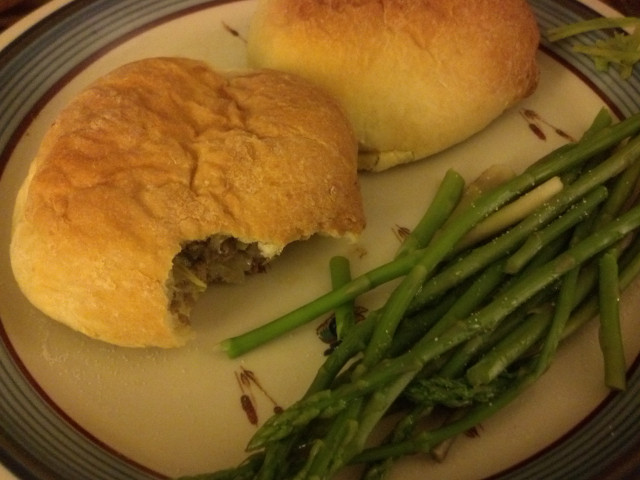
The previous weekend, I made a gigantic batch of these little delights,
using 4 pounds of ground chuck, 2 heads of cabbage, 5 onions, 13 cups of
flour, 13 egg yolks (which left me 13+ egg whites for breakfast for 4 days)
and a few other ingredients. It was a huge undertaking, but it produced 61
delicious krautburgers that went into the freezer and should provide about
30 meals! Each krautburger cost, by my estimate, about
$0.41, $0.47 (see cabbage roll
cost update), and two of them make a good meal for only about
$0.82 $0.94! I've learned that making a huge batch will
last for weeks or months, and is as easy as making a smaller batch.
Because I'm going to be eating Krautburgers many times over the next 45 days, I'll publish the recipe and the cost breakdown later. Update: the recipe was published on day 13 and the cost breakdown on day 16.
To combine my "Reduce Waste" and "Gifts are Free" rules, I ate half of the orange that I got in my Christmas stocking (I've never cared that much for most fruit, and I might have let it go to waste if not for this experiment,) and 6 cherries that my aunt canned this year and gave as Christmas presents. These were delicious! I also ate 1/8 of the pound of asparagus I bought for $0.99 / pound. (Put in microwave-safe ventable casserole dish, add 1/4 inch water, put the lid on, open the vent, and microwave for 7 minutes.) Later, I had a bowl of vanilla pudding that I made a few days earlier. A good day of eating, and quite cheap!
I have to admit that I went to bed the previous night feeling rather hungry. I expected this. The more I eat, the more I need to eat to feel satisfied. The less I eat, the less I need to eat to feel satisfied. My super-scientific hypothesis is that my stomach "shrinks" a bit when I don't eat. Since I had a semi-fasting day yesterday, I felt hungry. And I found it hard to sleep. Hope I adjust.
It's weird, but if I go to sleep hungry, I usually wake up not feeling hungry. It was hard not to snack before bed, but I managed to pull through.
About my usual eating schedule: I very rarely eat breakfast. Never have, at least since college. I'm usually not hungry in the morning, I'm always grumpy in the morning, (okay, I'm grumpy all day, always) and I'd always, always choose sleeping 5 more minutes over spending time eating! I'm usually fine with eating just one meal a day in the evening, and maybe a snack later. Everybody's schedule and needs are going to be different.
| Item | Cost |
|---|---|
| Krautburgers | |
| 2 Krautburgers (total 10.1 oz) (revised) | $0.94 |
| Asparagus | |
| 1/8 pound asparagus @ $0.99/lb | $0.13 |
| Vanilla Pudding | |
| 1/6 box instant pudding, Kroger house brand | $0.16 |
| 1/2 cup milk | $0.10 |
| Pudding subtotal | $0.26 |
| Homemade Kimchi (76 g) | $0.15 |
| Daily Total | $1.48 |
Egg salad sandwiches are one of my favorite sandwiches ever—they're rich and luxurious and filling. I always considered them to be rather expensive and difficult, but they're quite the opposite. They're especially cheap if you have cheap eggs (Albertson's had a dozen eggs for $0.99, which is considerably cheaper than the average $2.19/dozen.) And if you have eggs that are already hard-boiled, as I did, it's even easier.
(I didn't actually boil the eggs, though. I steamed them in my Breakfast Machine, which I love. It's a toaster that can also cook 1 to 4 eggs, either poached/steamed, soft-boiled, or hard-boiled. (There's also a 4-slice, 8 egg model.) Fill it with the appropriate amount of water (it comes with a cup marked with the right amounts of water for hard, medium, soft, and poached eggs,) and push the button, and you have perfectly-cooked eggs. This is good because I've never been good at getting eggs cooked just right; I live at more than a mile above sea level, and water boils at the lower temperature of 204°F (95°C), so none of the "never fail" egg-boiling recipes you hear ever work right for me. A "3-minute egg" is still basically uncooked.)
I made egg salad by mashing 3 hard-boiled eggs with 80 grams of mayonnaise, a tiny squirt of mustard, and some salt and pepper. That's it! I should note most strongly that if you put anything else (like celery) into your egg salad, you are a terrible monster. Also, egg salad is best on plain old soft cheap white bread. (There's also nothing more elegant and delicate for your afternoon tea than an egg salad sandwich with the crusts cut off!)
Each sandwich only used about 3/4 of an egg, (about $.06 at my good egg prices,) $0.08 of mayonnaise, and $0.10 of plain old white bread, for a total of $0.24 per sandwich. I had one and a half sandwiches, a few chips that I still had open (I weighed them to see how much they would cost) and felt like a king.
(By the way, I saw an egg salad sandwich at the grocery store for $4!)
Today, I went shopping at Albertson's, with a carefully-selected shopping list based on their weekly advertisement. Since it's a Friday during Lent, I planned on making a fish dish. (I've never understood how eating fish was in any way a sacrifice, though.) I had an interesting recipe for fish chowder (which I've never made before,) which sounded filling (it had potatoes and milk). Albertson's advertised frozen tilapia, swai, and pollock on sale for $2.99/lb. These fish can be somewhat bland, but that's a pretty good price for fish. This was my plan.
However, when I looked at the frozen fish, I saw that they had whole frozen pink salmon for $1.99/lb! Salmon is one of my very favorite fish, and that is a fantastic price for salmon, which is usually 7 to 10 dollars per pound, so I made the decision on the spot to buy a whole salmon and eat plain salmon instead! (They had the same deal on whole salmon a year ago, and I didn't buy one, and I was sad for the whole year!)

2.25 pounds of salmon for only $4.48!
It was kind of scary, because the fish I picked was rather large (2.25 pounds) and frozen solid. I hoped I'd be able to cut it and save portions for later. Luckily, a rough serrated knife sawed through the completely-frozen fish quite easily, allowing me to separate it into portions for freezing:
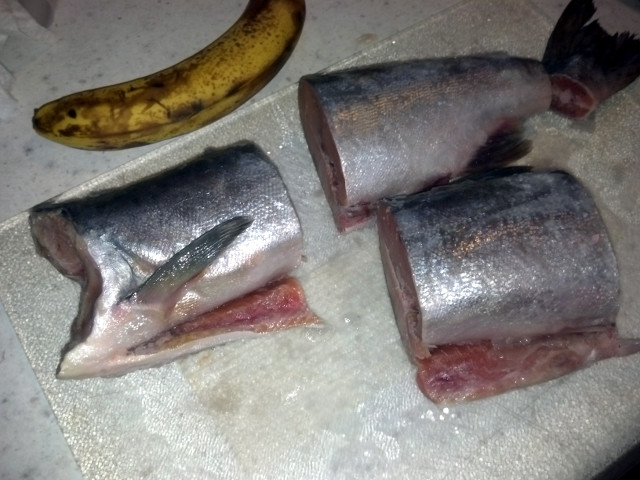
I'm not good at butchering whole fish, but a long, thin, flexible knife let me remove the backbone and fins without much problem.
I prepared a couple of baked potatoes by first microwaving them (using the "potato" button) and then brushing them with a bit of olive oil and kosher salt and finishing them in a 400°F oven (for crispiness.)
While the potatoes were cooking, I brined and thawed the salmon in cold water for 30 minutes with some sugar and salt. You know sometimes when you cook salmon and the yellow, buttery-looking albumin comes out in blobs on the surface of the fish? It doesn't look great, but brining prevents the albumin from leaking out and adds flavor to the fish. This is extremely important when smoking salmon, too!
Since the oven was not at the right temperature for cooking salmon (I either bake it low and slow or under a hot broiler,) I decided to pan-fry the salmon using a technique that I learned from Eric Ripert that gives you super-crispy, yummy skin. You dry the skin very well, and sprinkle the skin with a bit of salt, pepper and a fine dusting of Wondra flour. Then pan-fry, skin down, with a little bit of oil and butter, pressing the fish down, cooking for 80% of the time on the skin side, and turning over briefly to finish.
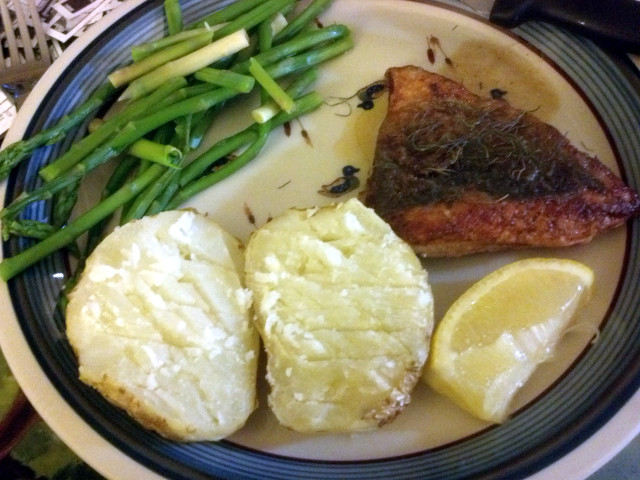
As you can hopefully see, the salmon skin was gorgeous and crisp. I had salmon, 2 baked potatoes (with butter and sour cream, not pictured,) asparagus, and a slice of lemon. The 6.25 ounce portion of salmon itself only cost $0.77! Amazing! Oh, and that's free dill from my aunt's garden on top of the salmon! Note the additional costs below.
| Item | Cost |
|---|---|
| Egg Salad Sandwich (prices are for 1 sandwich) | |
| 3/4 Egg | $0.06 |
| Mayonnaise | $0.08 |
| 2 slices white bread | $0.10 |
| 1 sandwich subtotal | $0.24 |
| 1.5 sandwich subtotal: | $0.36 |
| Chips | |
| Fritos | $0.08 |
| 1/2 oz potato chips | $0.09 |
| Chips subtotal: | $0.17 |
| Salmon | |
| 6.25 oz salmon at $1.99/lb | $0.77 |
| Olive oil for cooking | $0.20 |
| 1/8 large lemon | $0.11 |
| Salmon subtotal: | $1.08 |
| Asparagus | |
| 1/8 pound asparagus @ $0.99/lb | $0.13 |
| 2 Baked Potatoes | |
| 2 potatoes, approx 12 oz total | $0.30 |
| Butter, 3 Tbsp | $0.24 |
| Sour cream, 2 oz at $1.69/(16 oz) | $0.21 |
| Baked potato subtotal | $0.75 |
| Daily Total | $2.49 |
The total of $2.49 is very close to my target! I would have never thought I could have salmon on this budget, but it worked out wonderfully, and I have several more portions of salmon in the freezer!
How is it possible that one of the most delicious cuts of meat you can buy is also one of the most inexpensive? Nothing is more luxurious than a falling-apart-tender pork shoulder with its delicious mix of meat, fat, and gelatin. The only trick is to cook it correctly, and that's not even a trick. Pork shoulder requires low and slow heat for a long time to become tender. This is where your slow cooker (also known as a crock pot) comes in. A slow cooker is almost fool-proof. In the morning, you can drop in your roast with some onions, seasonings, and liquid, set it to low, and come back 9 hours later for meat that's as tender as any you've ever tasted.
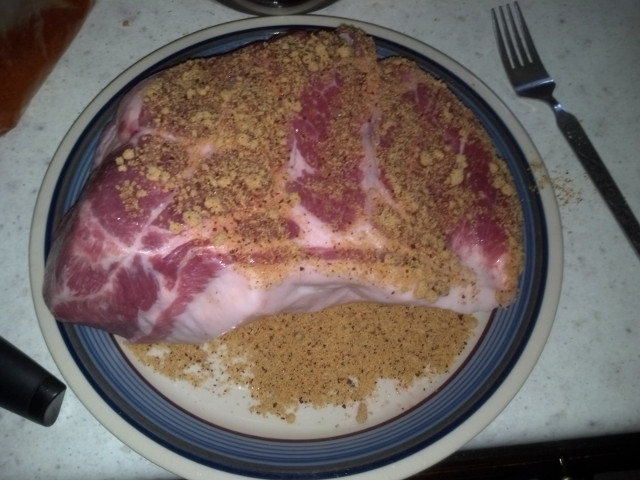
I rub you, my delicious pork shoulder.
And that's what I did. In the morning, I took out the crock pot, set it to low, put in 3 chopped onions, took a pork shoulder and covered it with my homemade spice rub, and set it on top of the onions, and added hot water to cover. I then walked away. (Okay, I came back to add water as it warmed up. More about that tomorrow when I discuss the science of meat temperatures.)
Nine hours later, the house smelled amazing, the roast was tender, and the crock pot was filled to the top with rich, delicious broth. Let me make a very, very important point:
Save that broth!
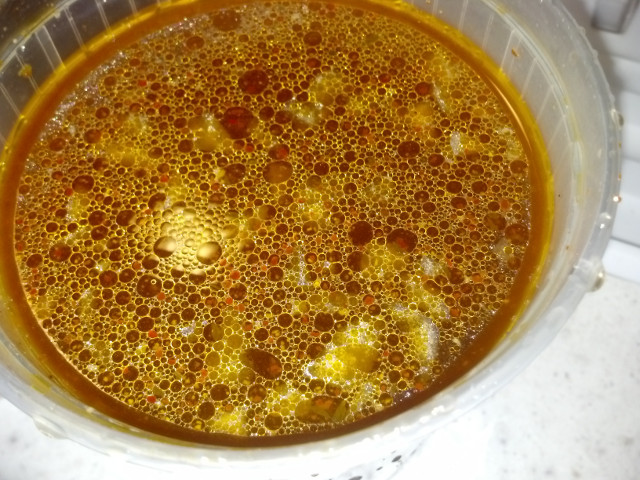
I will repeat that:
Save that broth! I had 4 quarts of dark, delicious, flavorful pork broth into which the fat, gelatin, meat juices, onions, and spices had mingled. You can freeze this broth and make the most amazing ramen you've ever tasted. Which I'm going to do soon.
The pork shoulder was 3.41 lb at $1.99/lb, and it will make several meals of pork tacos. Shredding the pork for tacos is easy. Put some of it in a bowl, and take two forks and shred it. It just pulls apart. The tacos had shredded cheese (which I got for the very good price of $2.88/lb,) soft flour tortillas, and shredded cabbage.
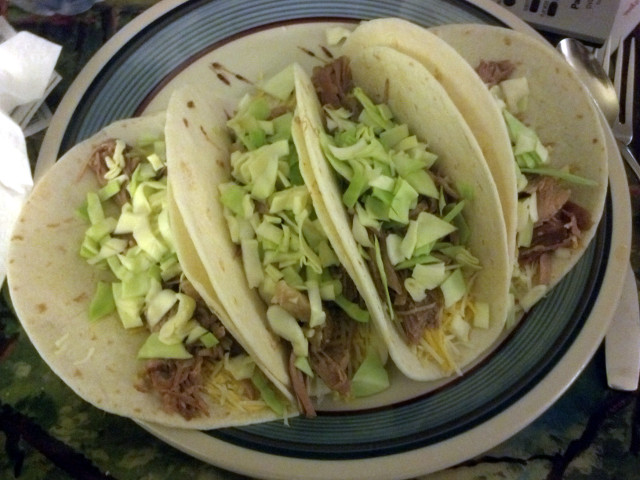
It's a bit difficult to estimate the cost of the pork that went into each taco until all the pork is gone (which will take several days.) Much of the original pork's mass went into the broth in the form of melted fat, gelatin, and meat juices, so weighing the final pork isn't enough to get a cost estimate. I weighed all the other ingredients, though, and estimated a final cost of about $0.51 per big yummy taco. I ate 4 tacos, so the estimated total for dinner was $2.04, for a very satisfying and balanced meal.
The tacos have all your major food groups: grains, dairy, meat, and vegetables. Nothing more is required!
For lunch, I had one and a half egg salad sandwiches and some kimchi, like yesterday.
| Item | Cost |
|---|---|
| Egg Salad Sandwich (prices are for 1 sandwich) | |
| 3/4 Egg | $0.06 |
| Mayonnaise | $0.08 |
| 2 slices white bread | $0.10 |
| 1 sandwich subtotal | $0.24 |
| 1.5 sandwich subtotal: | $0.36 |
| Homemade Kimchi (76 g) | $0.15 |
| Pork tacos (prices are for 1 taco) | |
| 0.5 oz cheese at $2.88/lb | $0.09 |
| 1 6" flour tortilla | $0.08 |
| Cabbage | $0.02 |
| Shredded pork (revised) | $0.24 |
| Onion | $0.04 |
| 1 taco subtotal: | $0.47 |
| 4 taco subtotal: | $1.88 |
| Daily Total | $2.39 |
Wow! Very close to my goal, but 5 cents over.
Update: The price of pork was recalculated
after the pork was done, bringing me back under budget. Some of the
costs that I've charged to this meal are actually in the 4 quarts of broth
that are going to be used in future meals. Saving the broth effectively
makes these future meals cheaper or free! I'm not going to try to do
"creative bookkeeping" here, but track my costs honestly and
conservatively. I consider today a success.
Breakfast/lunch was french toast and fried potatoes. As I mentioned on day 3, whenever you're baking potatoes, make another one or two for fried potatoes the next day. Fried potatoes are much quicker and better when the potato is already mostly cooked! If they're not cooked already, it's hard to get the inside of the potato cooked without overcooking the outsides. The fried potatoes cost $0.12 for about 4 ounces of potatoes.
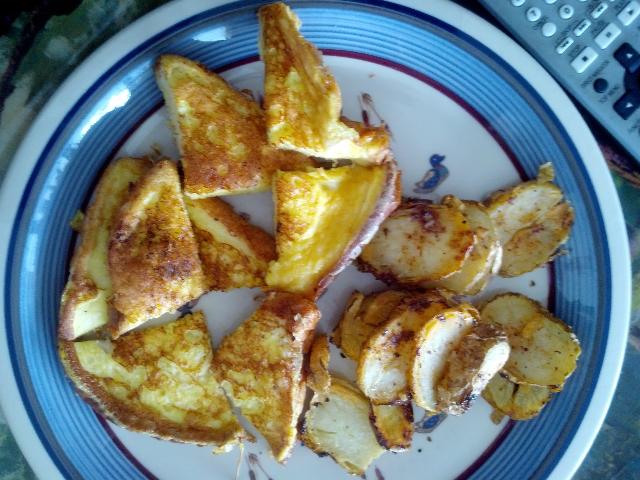
French toast is easy, and contains two inexpensive ingredients: eggs and bread. (And a little milk and sugar.) It turns out that each slice of toast uses 1/2 of an egg, so the total cost per slice was $0.10. I had two slices. Breakfast/lunch cost $0.32.
Dinner was exactly like day 4—more delicious pork tacos! I believe that I greatly overestimated the amount of pork that I used on day 4, so I may go back and revise the cost of these meals after all the pork is gone, and I can divide the cost of the pork by how many tacos it made.
Since I wrote about the pork tacos on day 4, as promised, I'm going to drop some meat science on you!
A pork shoulder, uncooked, is a rather unruly chunk of meat. It's a mix of intermingled muscle and fat. As you may know, whenever muscle connects to fat, or muscle connects to bone, there's some connective tissue (commonly known as gristle when not cooked correctly) which is unchewable and not good eats. However, when a pork shoulder is slow-cooked for 9 or more hours at low temperature, you can eat every single bit of the shoulder, and it's smooth and delicious! The connective tissue is no longer a problem. What happened to it?
The connective tissue is made mostly of collagen, a tough protein. You can think of collagen as a three-stranded rope, which it strongly resembles. It's a helix of three strands wound around each other. When you cook collagen above about 145°F (63 °C), the three strands begin to unwind from each other. Each strand is gelatin. Gelatin is an interesting protein that can hold up to 10 times its mass in water. However, there's not much water originally in this gelatin strand. With enough time and moisture, these gelatin strands will absorb water from the surrounding cooking liquid and muscle fibers (which squeeze out their own moisture as they heat up.) This makes a rich gel that keeps the meat moist and delicious.
Breaking down collagen into gelatin and making the gelatin absorb water is a process that takes both heat and time. Collagen breaks down into gelatin and absorbs water well at temperatures around 174°F (79°C), which is the temperature that a good slow cooker on low setting should hold. Collagen will break down and absorb water at even lower temperatures, but it takes significantly more time.
(My slow cooker gets significantly hotter than this, eventually boiling (at the altitude I live, that's 204°F (95°C)) at the edges even on the low setting, so I like to start cooking with just enough water to cover the roast, and add more water as it gets too hot (as measured by a probe thermometer) eventually filling it to the top so I have lots of good broth. Starting with a small amount of water is smart because a crock pot heats quite slowly. (My simple crock pot heats at only 215 watts on low and 335 watts on high.) Before your crock pot reaches 140°F (60°C), you are in the so-called "danger zone" where bacteria can grow. You thus want to start with hot water to minimize time in the danger zone.)
Note: Collagen also holds muscle fiber to muscle fiber, which is why you can shred individual fibers of the pork shoulder apart with a fork after breaking down the collagen with long, slow cooking. This further tenderizes the meat, and holds moisture in the gelatin between muscle fibers.
Cooking a pork shoulder at 174°F to 190°F for 9 or more hours makes it moist and luxurious. This is a cut of meat with lots of collagen, which turns to gelatin, which holds liquids in the meat and keeps it moist and tender.
However, if we tried to cook a lean piece of meat (without much connective tissue) this way, we would absolutely murder it and turn it into a dry, tight brick. As meat gets much warmer than about 140°F (60°C), the muscle fibers and connective tissue contract and squeeze moisture out, making the meat very dry. A piece of lean meat cooked at these temperatures for this amount of time would be tough and dry, especially because there's no gelatin to hold 10 times its mass in moisture in the meat.
(For comparison, beef is a nice medium-rare at 131°F (55°C) and lean pork is "done" and no longer pink at 145°F (62.7°C).)
"Stew meat" that cooks a long time in stews or chilis is usually something like pork shoulder or beef brisket with lots of collagen. You won't improve your stew by putting in filet mignon or ribeye steak. But pork shoulder or beef brisket are actually made better by long, slow, moist cooking at temperatures that would tie leaner meats into tough knots.
I'll write more later about the two major proteins in meat, and why breaking one down protein (myosin) is good, and breaking the other protein (actin) down is bad, and how you can have the best of both worlds with the right cooking technique. (Hint: it's called "sous vide".)
| Item | Cost |
|---|---|
| French Toast (per slice) | |
| White bread, 1 slice | $0.05 |
| 1/2 egg | $0.04 |
| 1 tablespoon milk | $0.01 |
| 1 slice subtotal | $0.10 |
| 2 slice subtotal: | $0.20 |
| Fried Potatoes | |
| Potatoes, ~4 oz | $0.10 |
| Vegetable oil | $0.02 |
| Potatoes subtotal | $0.12 |
| Pork tacos (prices are for 1 taco) | |
| 0.5 oz cheese at $2.88/lb | $0.09 |
| 1 6" flour tortilla | $0.08 |
| Cabbage | $0.02 |
| Shredded pork (revised) | $0.24 |
| Onion | $0.04 |
| 1 taco subtotal: | $0.47 |
| 4 taco subtotal: | $1.88 |
| Daily Total | $2.20 |
Again, I won't know the pork cost per taco until all the pork is gone, so I may revise these figures. The pork cost for day 4 was almost certainly overestimated, and I'm easily back within my budget today.
Update: The price of pork was recalculated after the pork was done.
After shoveling heavy snow and breaking ice for almost two hours at very cold temperatures, I had 3-inch-long icicles of sweat hanging from my hair, and I was ready for a shower and a huge hot bowl of ramen noodles!
Luckily, as you may remember from day 4 when I made Pork Tacos, I saved the delicious broth from the slow cooker, which is the secret for the best ramen you'll ever have:

That broth paid off. It's rich and thick and delicious. So rich, in fact, that I diluted it to half-strength. The 4 quarts of broth that I saved will go quite a long way.
The other secret ingredient for making ordinary ramen extraordinary is your refrigerator's friend, Bok Choy! I hadn't used Bok Choy much in the past, but it's an incredibly tolerant and long-lasting vegetable. It will stay fresh in your refrigerator for far longer than you'd ever expect. Just buy a big head for about $1.00/lb and break off what you need. (Baby bok choy is beautiful and cute, but it costs about 5 times as much in my local supermarket. You may be able to buy it cheaper in Asian supermarkets, which may have 10 different types of little bok choys, sometimes in huge bags.)
Long after cabbage and lettuce and other vegetables have wilted or molded in your fridge, the Bok Choy will still be good. Chop it into pieces, and boil it in your broth for about 7-10 minutes. It maintains a very nice crisp texture even if you under- or over-cook it, and it absorbs the flavor of the broth, making it quite delicious. 3.2 ounces of bok choy cost $0.20.
After the bok choy cooked, I boiled a packet of cheap ($0.16) chili-flavored ramen in the broth for the usual couple minutes. I then put it in a giant bowl (29 fluid ounces!) and, for an extra bit of flavor and protein and richness, I cracked a raw egg ($0.08) into it, which cooked in the hot liquid.

That was unbelievably delicious and rich. Look at that broth! That's nothing like your usual ramen-seasoning-packet broth, and there was more than twice as much of it! There was even broth left over after re-filling my bowl partway. More than two pounds of hot, delicious ramen soup in my belly made me feel a lot warmer.
While I ate my ramen, I watched a Simply Ming episode in which chef Ming Tsai makes elaborate, super-expensive ramen with a new Japanese Iron Chef. They used A-5 grade Kobe beef, smoked maitake mushrooms, dried scallops, mussels, and many more super-expensive ingredients. I'll bet I was every bit as satisfied with my delicious bowl of ramen that cost about $0.54. (For this price I could only buy about 1.5 grams of A-5 kobe beef. For comparison, a U.S. dollar bill has a mass of about 1 gram.)
By the way, I forgot to account for the cost of the spice rub that I put on the pork shoulder in day 4, which made the broth so delicious, so I'll account for it below.
Tiny little jars of commercial spice rub for cooking meat are incredibly expensive (maybe $4 for a 1.75-oz jar) and meat takes a lot of rub! I make my own spice rub with some inexpensive ingredients I have in my cupboard. I usually make a fairly large batch and have some left over, because it's good to sprinkle on anything from meat to fried or baked potatoes to vegetables. The proportions for my spice rub are somewhat like:
Brown sugar is relatively cheap. A good rule of thumb is that it's $1.00/lb, or about twice as expensive as white sugar. A cup of brown sugar costs $0.50. I'm going to wildly overestimate the total cost of the big batch of rub that I made as $1.50, about half of which went into the broth (and I have half left over.) Since there's enough broth for about 8 huge bowls of ramen, I'll call it $0.10 in spices per bowl.
Dinner was pork tacos again. I definitely have overestimated how much the pork cost, so I'll revise the above calculations when I'm done. There's still enough for a few more pork tacos.
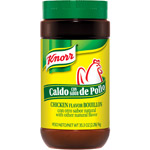 By the way, a good way to buy spices more inexpensively is to go to what
Walmart calls the "Hispanic Foods" aisle. This is especially true for
bouillon powder. Walmart sells a giant jug that they call "Knorr Hispanic
Chicken Granulated Bouillon, 35.3 oz" for $4.98. This is a fraction of the
cost of bouillon in the spice aisle. I use this in a lot of
recipes, and it lasts me many months.
By the way, a good way to buy spices more inexpensively is to go to what
Walmart calls the "Hispanic Foods" aisle. This is especially true for
bouillon powder. Walmart sells a giant jug that they call "Knorr Hispanic
Chicken Granulated Bouillon, 35.3 oz" for $4.98. This is a fraction of the
cost of bouillon in the spice aisle. I use this in a lot of
recipes, and it lasts me many months.
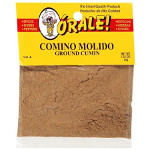 The "Hispanic Foods" aisle of your grocery store may also contain other
spices much cheaper. I usually get cumin, chili powders, and
other spices in this aisle, usually under the "Órale!" brand. These
spices come in bags instead of jars, and cost about 1/3 what they do a
couple aisles away.
The "Hispanic Foods" aisle of your grocery store may also contain other
spices much cheaper. I usually get cumin, chili powders, and
other spices in this aisle, usually under the "Órale!" brand. These
spices come in bags instead of jars, and cost about 1/3 what they do a
couple aisles away.
Another great place to buy inexpensive spices in bulk is Indian markets. These often have bags of spices like cardamom, cumin, coriander, cinnamon, mustard seeds, sesame seeds, and a wide variety of chili powders for drastically lower prices than you can find them elsewhere.
| Item | Cost |
|---|---|
| The World's Best Ramen | |
| Broth, spices | $0.10 |
| Bok choy, 3.2 oz | $0.20 |
| 1 egg | $0.08 |
| Ramen (1 pkg) | $0.16 |
| Ramen subtotal: | $0.54 |
| Pork tacos (prices are for 1 taco) | |
| 0.5 oz cheese at $2.88/lb | $0.09 |
| 1 6" flour tortilla | $0.08 |
| Cabbage | $0.02 |
| Shredded pork (revised) | $0.24 |
| Onion | $0.04 |
| 1 taco subtotal: | $0.47 |
| 4 taco subtotal: | $1.88 |
| Daily Total (revised) | $2.42 |
A few cents over budget again, but I'll recalculate when all the
pork is finished.
Update: The price of pork was recalculated after the pork was done, bringing me just back under budget!
Breakfast was a bowl of quick oatmeal. I can count on one hand the number of times I've eaten oatmeal in my life, but it was very good (once you add brown sugar.) Total cost: $0.16.
Containers are starting to sprout strange new labels:
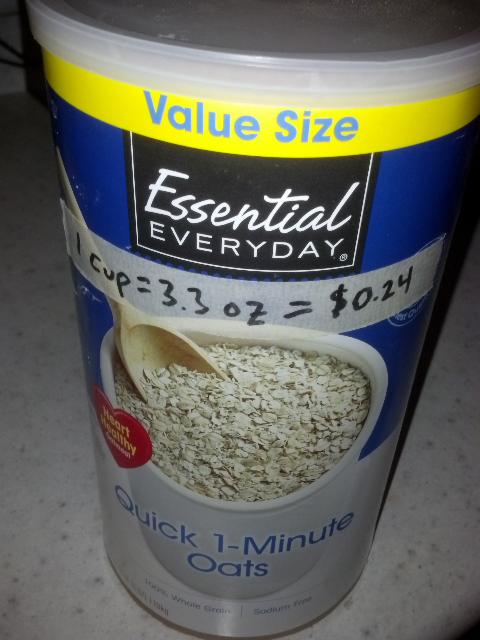
That gigantic container cost less than a much smaller can of Quaker brand oats. ($2.99)
For lunch, I had a hot dog on a bun. Unfortunately, the purchase of these hot dogs (Oscar Meyer Classic Bun-Length, my favorite) predated this experiment, so they weren't the most cost-effective. I have newer hot dogs that cost 1/3 the price. A hot dog was $0.32, and a bun was $0.16, for a total of $0.48 for a single hot dog. (I have cheaper hot dogs that I could eat on bread for a total $0.15, less than 1/3 the price.) However, my rules for this experiment are that anything I have to throw away, I have to charge myself for, so chow down, wide load.
It's sort of funny how upset I get when I see something in an advertisement that's much cheaper than I just paid for it. For example, last week I bought 10 pounds of potatoes for $2.99, which I thought was a pretty good deal. But yesterday I saw the same bag at the same store for $0.99! That made me sad. I started thinking, "well, I could still eat 8.3 pounds of potatoes a day at the old price. Or 25 pounds a day at the new price." At this moment, I became enlightened. If I were ever hungry, I could eat a bunch of potatoes. The only thing I'd have to be wary of is spending too much money on stuff like butter, sour cream, or sauce (Mae Ploy sweet chili sauce is really good on boiled potatoes!)
So how could I make a bunch of ready-to-eat, delicious long-lasting potatoes? The answer came from a recipe I've made for many a St. Patrick's Day party: Colcannon.
Colcannon is an Irish dish (in Irish Gaelic, cál ceannann, meaning "white-headed cabbage",) made with mashed potatoes mixed with cabbage. Other variations use kale, leeks, onions, and scallions, in addition to possibly ham or bacon.
Since a stick of butter costs around $1.00, I decided to try to use the cabbage to keep the mashed potatoes moist, and eliminate butter or cream entirely. I boiled/steamed some cabbage with water and salt, and saved the cabbage water. This got added to 3.5 pounds of mashed potatoes. The result was still far too dry, so I added 2 cups of milk (which was probably a bit too much.) This made 4.5 pounds of finished Colcannon, all for the price of $1.96! I'll have this ready to eat with any meal.
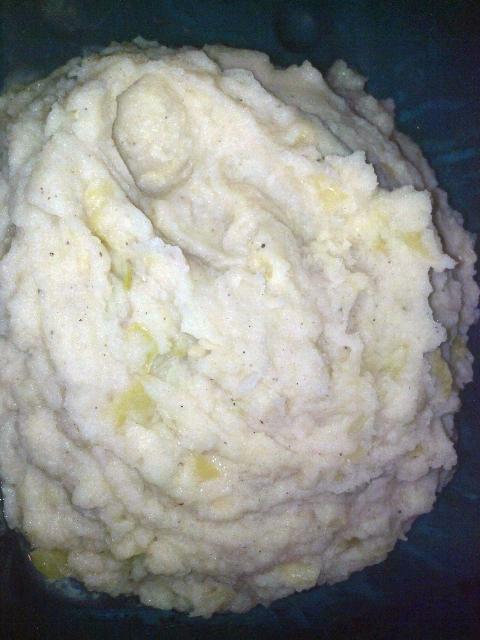
By the way, a big potato ricer makes making mashed potatoes immensely easier and more repeatable. A potato ricer is basically an extruder press that you put boiled potatoes in and squeeeeeeze them through little holes. (It's like a Fuzzy Pumper Barber Shop (which I always wanted as a kid) but instead of being for Play-Doh, it's for food!) No mashing! You don't even need to peel the potatoes! The potato skins stay in the ricer. And when you cut up the potatoes for boiling, you can cut them into very large, coarse pieces. All of these benefits make mashed potatoes in a ricer much simpler than the traditional method.
The original plan was to finish up the pork tacos for dinner, but I happened to see an episode of Simply Ming in which chef Ming Tsai's dad used a bunch of leftover pork and onions and some simple dough to make crispy pancakes! So that became the new plan.
The "hot water dough" was simple enough:
Mix the three together, knead them for about 6 minutes, and then let it rest, covered, for about an hour. There's no leavener, so they don't rise, so you could probably skip this step if you're in a rush. The dough cost $0.32.
Roll the dough out as thin as possible on a well-floured surface, spread a
thin layer of vegetable oil over the whole surface, and then spread
leftover cooked pork, cooked onions, and cooked cabbage over the whole
surface. Roll tightly like a jelly roll into a long cylinder. Cut the
cylinder into about 4-inch (10 cm) lengths, try to twist the ends shut
(just try) and then twist and squish the cylinders from end to end into a
thin, flat pancake:

Fry them with a bit of oil in a hot skillet, about 375°F (190°C) for about 3 minutes on each side or until crisp and brown.
These were quite good! I'd definitely make them again with leftovers. The breading is very inexpensive ($0.32 for the entire batch) and it stretches the remaining pork nicely. This was the first dinner that I've actually felt full after eating (along with 6 oz Colcannon.)
As noted before in the last 3 days, it was difficult to estimate how much pork cost per serving until I was done with the pork. The pork shoulder, which cost $6.79, made 28 portions, which is 7 more portions than I originally estimated. Thus, I've revised the last few days' pork prices downward to $0.24 per portion, a reduction of $0.04 per portion. This actually means that the last few days were under budget as I'd hoped!
flourcost = 2.50 dollars/(5 lb)
1 cup flour_scooped flourcost
0.15625 dollar (currency)
Note that Frink knows the average density of flour in many forms,
including scooped or sifted. flour_scooped is the density
of scooped flour.
??flour in its interactive interface. (Or just click that link.)
??sugar in its interactive interface. (Or just click that link.)
| Item | Cost |
|---|---|
| Oatmeal | |
| Oatmeal, 1/3 cup (uncooked volume) | $0.08 |
| Milk, 1/4 cup | $0.05 |
| Brown sugar, 1 tablespoon | $0.03 |
| Oatmeal subtotal: | $0.16 |
| Hot Dog | |
| Hot dog (Oscar Meyer Classic Bun Length) | $0.32 |
| Hot dog bun | $0.16 |
| Hot dog subtotal: | $0.48 |
| Colcannon (price for 73 oz) | |
| Potatoes, 3.5 lb | $1.05 |
| Cabbage, 8.3 oz | $0.51 |
| Milk, 2 cups | $0.40 |
| Colcannon, 73 oz subtotal | $1.96 |
| Colcannon, 6 oz subtotal | $0.16 |
| Pork Pancakes (prices are for 1 pancake.) | |
| 2/7 cup flour | $0.05 |
| 1/7 yellow onion | $0.04 |
| Cabbage | $0.04 |
| Oil | $0.01 |
| 1 pancake subtotal: | $0.38 |
| 3 pancake subtotal: | $1.14 |
| Daily Total | $1.94 |
Today was a simple lunch of a Braunschweiger (liverwurst) sandwich, one of my all-time favorites. The Braunschweiger component of the sandwich cost $0.31 out of about $0.42 total, so it's a fairly economical sandwich. (The Braunschweiger I got was $2.50/lb which is fairly good for a meat product.) I didn't have any lettuce, so I put on a few cabbage leaves I had left over.
I also had some homemade kimchi, a very small amount of potato chips, and half of some sort of lovely pear (Bosc, I believe) that was in the fridge from before this experiment began (again, if it goes to waste, I have to charge myself for it.) I don't remember how much it cost, but fruit can be very expensive and blow my budget easily. (A single honeycrisp apple, for example, can be $1.79!) I'm going to take the worst-case scenario and estimate the whole pear at $1.00, which is the current selling price of fancy Asian pears in the advertisements. This could easily wreck my budget, and I may revise the price when I go back to the grocery store.
(I lived in Germany for 6 months on a youth exchange when I was 21, and dinner in all of my families was almost always a cold dinner of good, dense German bread along with cold cuts of meat and cheese and butter, and something like tomatoes. The meats were always delicous, but Leberwurst was always my favorite (until I got the courage to try the steak tartare, which then became my favorite. Sorry, liverwurst.))
Dinner was the last of the pork pancakes and colcannon, and a bit more asparagus. See day six for the cost breakdown of the pork pancakes and colcannon.
| Item | Cost |
|---|---|
| Braunschweiger sandwich | |
| Braunschweiger (Kroger house brand), 2 oz @ 2.50/lb | $0.31 |
| White bread, 2 slices | $0.10 |
| Cabbage | $0.03 |
| Braunschweiger sandwich subtotal: | $0.42 |
| Homemade Kimchi (76 g) | $0.15 |
| 1/2 oz potato chips | $0.09 |
| 1/2 Bosc? pear (estimated) | $0.50 |
| Colcannon, 6 oz subtotal | $0.16 |
| 1 pork pancake subtotal: | $0.38 |
| 1/8 pound asparagus @ $0.99/lb | $0.13 |
| Daily Total | $1.83 |
Before shoveling lots more snow in the morning, I wanted some quick energy so I ate half of a banana ($0.14) and a quick egg sandwich on two pieces of dry white toast from my Breakfast Machine. Why dry? Since I noticed the other day that buttering bread for grilled cheese sandwiches was rather expensive, I decided to save a few cents. I don't know how Elwood Blues eats dry white toast. Next time I'll butter it. Sandwich cost was $0.18.
For lunch, I had the most amazing ramen again, as described on day 6.
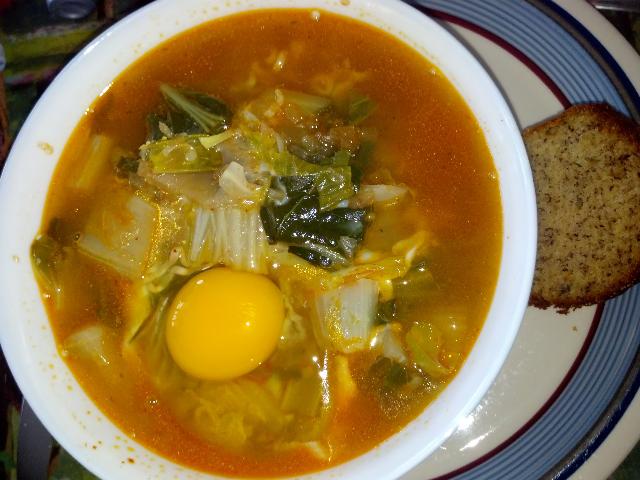
Saving the pork broth from day 4 keeps paying off. Look at that broth! I used up my bok choy, so the total cost was about $0.62. I was very full and had broth left over afterwards, which went to good use again, as you will see below.
Also, here's a loaf of my mom's award-winning banana bread, which is the best thing ever (and it's a great use for 3 bananas that were getting overripe):
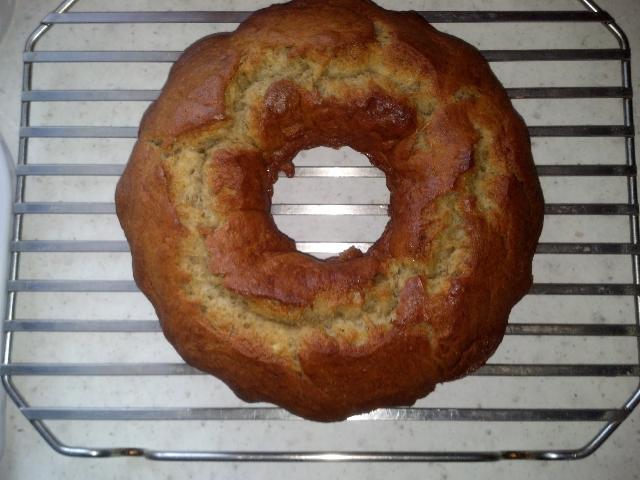
The whole loaf cost $2.52 to make. I ate about 1/16 of it, (I could have eaten the whole thing,) which cost $0.16. I ate the banana bread without butter. It was very good and moist. You can see a slice on the right-hand-side of the ramen picture above.
Many people have suggested dried beans as a cost-effective meal. I had some Urad Dal (a small, white lentil-like bean, also called "matpe bean" in English) from an Indian market.
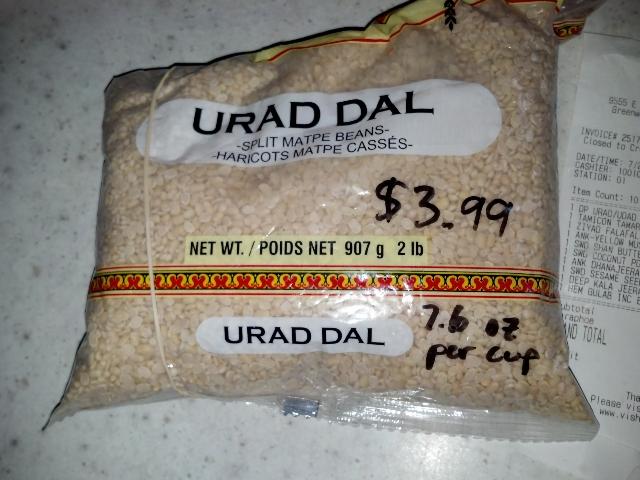
I've never used them before, so these became an experiment. 1 cup of dry beans (7.6 oz, cost $0.95) were brought to a boil in the leftover pork broth from lunch, reduced to a simmer and covered, and then simmered for about 45 minutes until they were soft.
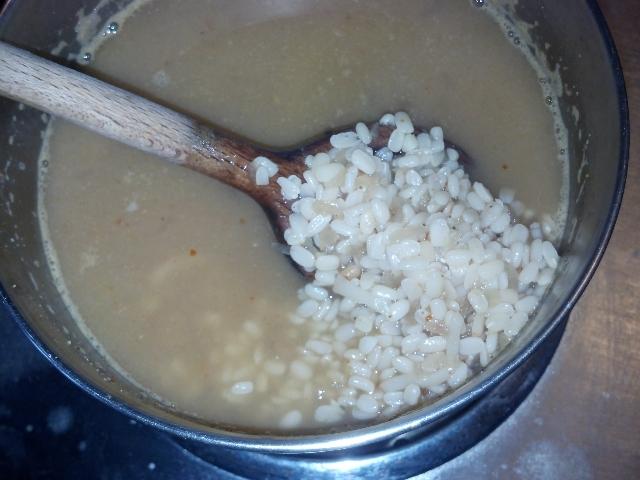
While they were cooking, they smelled exactly like Campbell's Bean and Bacon soup (which is one of my favorites!) Must have been the pork broth. When finished, they were slightly gelatinous and slippery. They were quite delicious and filling. I ate approximately 1/4 of the final product, for a cost of $0.25.
I tried adding other spices to the Urad Dal, such as garam masala and tikka masala powders, but it really didn't need it. The pork broth again worked its miracle!
Since I wasn't too hungry for dinner after the huge bowl of ramen, I also had a (relatively expensive) hot dog and some colcannon. After calculating my costs for the day, I was at $1.99, so I decided to have a bonus piece of banana bread, this time with butter (the butter cost only $0.03), which brought me to $2.12 for the day. Yum.
By the way, so far I haven't tried to eat as close to $2.50 as I can. I haven't needed to, as I haven't been significantly hungry.
This was the day that the internets exploded with the "What color is this dress?" debate, in which some people saw the the dress as white and gold, and others saw it as blue and black. In that spirit, here's another picture puzzle, which I took after making the ramen:
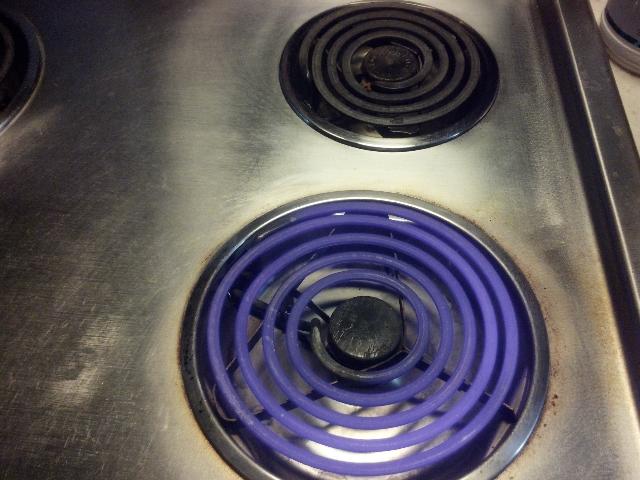
What color are the burners? Do you see them as blue and black (or white and gold?) I tell you that both burners are in fact, both the same color. Why do I say that? Send me your guesses ether on Twitter at @aeliasen or by email at eliasen@mindspring.com.
| Item | Cost |
|---|---|
| Dry egg sandwich | |
| 1 egg | $0.08 |
| White bread, 2 slices | $0.10 |
| Dry sandwich subtotal: | $0.18 |
| 1/2 banana | $0.14 |
| The World's Best Ramen, Again | |
| Broth, spices | $0.10 |
| Bok choy, 4.3 oz @ $0.99/lb | $0.27 |
| 1 egg | $0.08 |
| Ramen (1 pkg) | $0.17 |
| Ramen subtotal: | $0.62 |
| Banana Bread (cost for 1 loaf) | |
| 1 stick butter | $0.92 |
| 1 cup sugar | $0.27 |
| 2 eggs | $0.16 |
| 3 bananas | $0.84 |
| 2 cups flour | $0.32 |
| 1 teaspoon baking soda | $0.01 |
| Banana bread subtotal (1 loaf): | $2.52 |
| Banana bread subtotal (1/16 loaf): | $0.16 |
| Urad Dal ~2 oz of dry @ $3.99/(2 lb) | $0.25 |
| Hot Dog | |
| Hot dog (Oscar Meyer Classic Bun Length) | $0.32 |
| Hot dog bun | $0.16 |
| Hot dog subtotal: | $0.48 |
| Colcannon, 6 oz subtotal | $0.16 |
| Bonus banana bread | $0.10 |
| Butter, 3.5 g | $0.03 |
| Daily Total | $2.12 |
Lunch was 1.5 fried egg sandwiches with mayonnaise. See the calculations below for calculating the cost of mayonnaise (which is sold by volume, but I measured it by mass.) Total cost: $0.38. My stomach must be shrinking, because I was full after 1.5 sandwiches.
Since it was a Friday during Lent, a fish dish was in order for dinner. It was time to break out a delicious recipe that's at least 80 years old for Tuna Casserole! I obtained this recipe from my friend Richard who made it for a potluck, and everyone loved it. He generously gave me the old family recipe, which noted that his mother made it for his father on their honeymoon in 1935, and they ate the whole batch in one sitting!

It's a tuna casserole that's covered with bready pinwheels, and is really delicious and filling. It's quite easy to make, and may last more than one sitting if you can restrain yourself. There is no sacrifice in eating this dish; it's a year-round family favorite of more than one family! (By the way, if you do it right, your pinwheels will be prettier and actually look like pinwheels.)
The most expensive part of the dish is 4 cans of tuna, which I bought for $0.79/can, which is a fairly good price. You don't need whole chunk fancy tuna, as you're going to break it up anyway! I looked at large cans of tuna, but they were more expensive per ounce than small cans on sale. The body of the casserole is onions, green bell peppers, and tuna in a flour and milk sauce. (You can call it Béchamel sauce if you're fancy.) The rolls are made from Bisquick and milk, with a bit of cheese rolled in.
I modified the original recipe in a few ways: I reduced the amount of cheese in the rolls from 8 oz to 3.5 ounces (you can never taste it anyway), used one bell pepper instead of 2 (because I only had one) and eliminated the jar of pimientos that are usually sprinkled over the top (they're pretty, but I could never taste them.) Also, I had no nutmeg.
The whole casserole cost $7.98 to make (great!) so each of the 15 "pinwheels" marks a serving that cost $0.53 to make. I ate 3 pinwheels, and the last of the asparagus. Finding inexpensive tuna makes this quite an inexpensive recipe (the tuna was $3.16 of the total cost.)
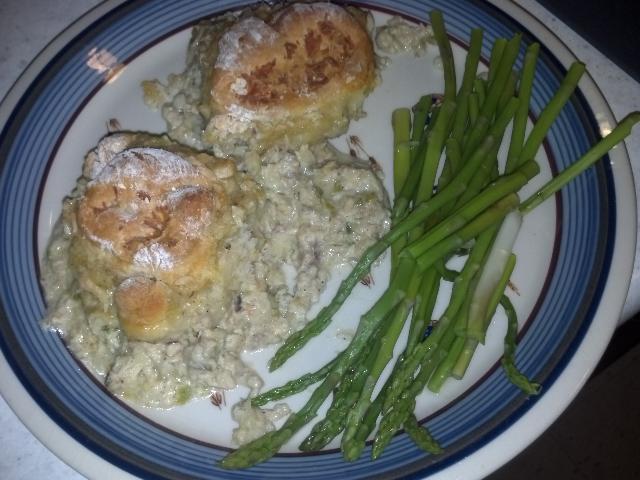
Since I'll probably be eating this casserole for another couple of meals, I'll post the recipe another day. Update: The recipe is posted on day 11.
After calculating my costs for the day, I had money left over, so I had another slice of banana bread with butter. Total daily expense: $2.23.
I mentioned before that I've created a calculating tool / programming language called Frink which is great for helping with physical calculations. Here's how to calculate the cost of mayonnaise (which is labeled by volume) but weighed by my scale. To do this, we either have to measure or look up the density of mayonnaise. We can easily search for the density of mayonnaise which gives "0.91 g/ml"). Each sandwich took a total of 0.75 oz (this is a mass) of mayonnaise:
mayocost = 3.48 dollars / (30 floz)
mayodensity = 0.91 g/ml
0.75 oz mayocost / mayodensity
0.0916 dollar (currency)
So light mayonnaise on (both sides) of a sandwich costs about $0.09.
| Item | Cost |
|---|---|
| Fried Egg Sandwich (prices are for 1 sandwich) | |
| White bread, 2 slices | $0.10 |
| 1.5 eggs | $0.06 |
| Mayonnaise, 0.75 oz | $0.09 |
| 1 sandwich subtotal: | $0.25 |
| 1.5 sandwich subtotal: | $0.38 |
| Tuna Casserole | |
| 15.75 oz (3 cups) Bisquick @ $4.94/(60 oz) | $1.30 |
| 3.5 oz cheese @ $2.88/lb | $0.63 |
| 4 cans tuna @ $0.79/can | $3.16 |
| 1 green bell pepper | $0.79 |
| 1 yellow onion | $0.30 |
| 1 stick butter | $0.92 |
| 1/2 cup flour | $0.08 |
| 4 cups milk | $0.80 |
| 1 casserole total (15 portions): | $7.98 |
| 1 portion subtotal: | $0.53 |
| 3 portion subtotal: | $1.59 |
| 1/8 pound asparagus @ $0.99/lb | $0.13 |
| Bonus banana bread | $0.10 |
| Butter, 3.5 g | $0.03 |
| Daily Total (revised) | $2.23 |
Lunch was a Braunschweiger sandwich with kimchi and a few chips. Total lunch cost, $0.66. Dinner was the tuna casserole from day 10 and some more colcannon.
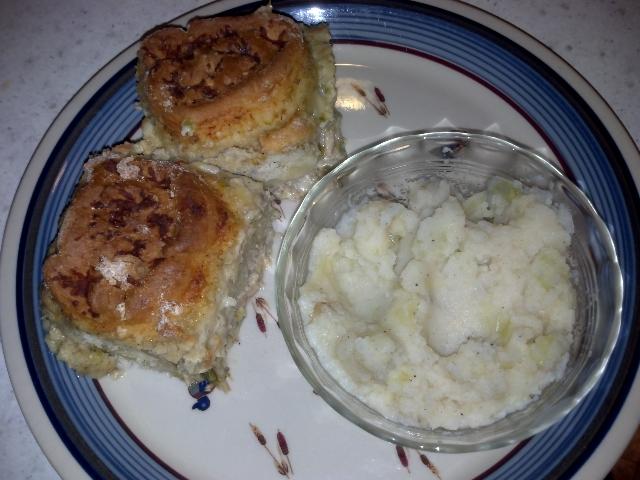
As promised, here's the recipe for the Tuna Casserole!
This is the original 80-year-old recipe for the tuna casserole. My suggestions follow.
Chop 1 large onion and 2 green peppers. Sauté in a melted stick of butter until glossy. Add 1/2 tsp salt, also pepper and nutmeg to taste. Add 1/2 cup flour and stir together well. Slowly, and over medium heat, add and stir in enough milk for a thinnish white sauce. Add 3 or 4 cans of drained tuna, stir, put into a 9x13 inch cakepan. Prepare a biscuit mix using 3 cups Pioneer or Bisquick mix with one cup of milk. Roll out into a rectangle 3/8 inch thick. Sprinkle 1/2 lb. shredded cheddar and one large jar of chopped pimientos over the biscuit mix. Roll up and cut into 12 equal-sized rolls. Place the rolls on top of the tuna mix. Bake at 350°F for 45 minutes.
Alan's suggestions:
| Item | Cost |
|---|---|
| Braunschweiger sandwich | |
| Braunschweiger (Kroger house brand), 2 oz @ 2.50/lb | $0.31 |
| White bread, 2 slices | $0.10 |
| Cabbage | $0.03 |
| Braunschweiger sandwich subtotal: | $0.42 |
| Homemade Kimchi (76 g) | $0.15 |
| 1/2 oz potato chips | $0.09 |
| Tuna casserole, 3 portions: | $1.59 |
| Colcannon, 9 oz. | $0.24 |
| Daily Total | $2.49 |
Today was like some days before -- oatmeal and half a banana for breakfast ($0.35), a braunschweiger sandwich and a very small amount of potato chips for lunch ($0.42), and the last of the tuna casserole for dinner. Daily total: $2.35.
That tuna casserole is excellent. I highly recommend it even if you're not trying to eat inexpensively. It's worth every penny.
At the end of the day, I had $0.15 left in my budget, so I had a small piece of banana bread with butter. Final total: $2.48.
| Item | Cost |
|---|---|
| Oatmeal | |
| Oatmeal, 0.57 cup (uncooked volume) | $0.14 |
| Milk, 1/4 cup | $0.05 |
| Brown sugar, 1 tablespoon | $0.03 |
| Oatmeal subtotal: | $0.22 |
| 1/2 banana | $0.13 |
| Braunschweiger sandwich | |
| Braunschweiger (Kroger house brand), 2 oz @ 2.50/lb | $0.31 |
| White bread, 2 slices | $0.10 |
| Cabbage | $0.03 |
| Braunschweiger sandwich subtotal: | $0.42 |
| 1/2 oz potato chips | $0.09 |
| Tuna casserole, 2.5 portions: | $1.33 |
| Colcannon, 6 oz. | $0.16 |
| Bonus banana bread | $0.10 |
| Butter, 3.5 g | $0.03 |
| Daily Total | $2.48 |
As promised on Day 2, here's the Cabbage Rolls / Krautburger recipe! They're a bun filled with cabbage, onions, and ground beef. They're delicious, nutritious, filling, inexpensive, and they freeze and microwave incredibly well, so you can make a giant batch and have cheap food ready in minutes!

This recipe is for a single batch but you should always plan on making at least a triple batch because they freeze extremely well, and it's just as easy to make a large batch. I made a larger-than-quadruple batch. A single batch will make about 15 krautburgers.
Sprinkle the yeast into 1/2 cup of the milk. Add the sugar and salt and stir until dissolved (actually it will stay clumpy because of the milk. Just let it sit for a while and it will unclump.) Place the mixture in a warm draft-free place for 5 to 8 minutes or until the mixture has begun to bubble. (It may take longer than that.)
Pour the flour into a large bowl and make a well in the center. Drop in the yeast mixture, egg yolks, remaining 1/2 cup of milk, and butter, and with a large wooden spoon, gradually stir the flour into the other ingredients until a fairly firm dough is formed. Cover the bowl and let rise in a warm place for an hour. (Over a bowl of warm water is good.) Punch down, let rise for another 45 minutes.
Preheat the oven to 375°F (190°C).
In a large pot with a lid, heat oil and cook onions with some salt for 5 minutes. Add cabbage, some salt and pepper (or bouillon powder for even more flavor,) and about 1/2" of water, cover pot and steam until cabbage is tender, stirring occasionally. Add small amounts of water if necessary while cooking. A little bit of onion and cabbage juice left in is good!
Lightly brown ground beef with garlic and do not drain. Mix beef with cooked cabbage and onions and season to taste. The filling will be easier to work with and less wet if cooled somewhat before using.
Cut dough into manageable sections and roll out on lightly floured surface (or unfloured on a dough sheet.) Roll thin using rolling pin. Cut dough into pieces (whatever size you like, about 4" square is good). Roll out again with a rolling pin for efficient use of your dough! Fill with a couple spoonfuls of filling. Fold corners of dough together, pinch closed, and turn over with seam down on cookie sheet. Bake in oven for 10-12 minutes or until golden. Cool on rack. Can freeze after cooled. These reheat very nicely in the microwave.
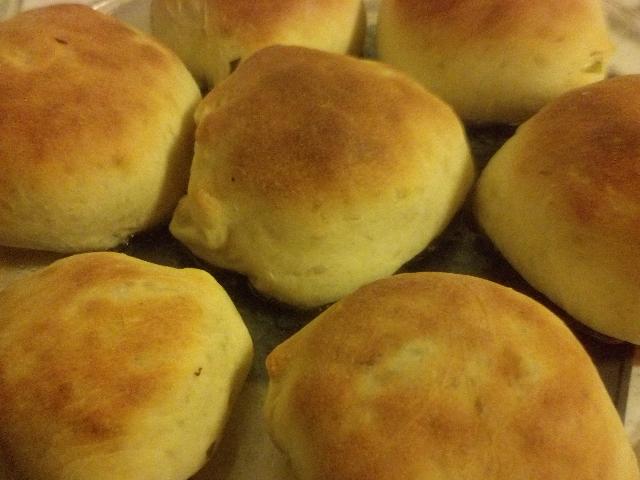
Update: I broke down the cabbage roll costs in day 16. Note that the final cost was about $0.47, an increase of $0.06 over my estimate. In another year, when ground beef was on sale, I made them for about $0.37 apiece with lots of filling left over!
Breakfast was a bowl of oats ($0.18). I've already eaten more oats in the last week than I have during the rest of my life combined (and I've only eaten about 3 bowls.) Lunch was a delicious egg salad sandwich (with the last egg that cost $0.08 and two new new super-cheap eggs that cost $0.04 each) and 1/4 cup of the Urad Dal from day 9. The Urad Dal was absolutely delicious. (Have I mentioned that you should save your pork broth?) Dinner was 2 cabbage rolls, the last of the colcannon, and, since I was well under budget, another 1/4 cup of Urad Dal.
After dinner, I had still only spent $1.55 for the day. As an evening snack, I had banana bread and tapioca pudding. Daily total: $1.96.
| Item | Cost |
|---|---|
| Oatmeal | |
| Oatmeal, 0.43 cup (uncooked volume) | $0.10 |
| Milk, 1/4 cup | $0.05 |
| Brown sugar, 1 tablespoon | $0.03 |
| Oatmeal subtotal: | $0.18 |
| Egg Salad Sandwich (prices are for 1 sandwich) | |
| 3/4 Egg | $0.04 |
| Mayonnaise, 15 g | $0.07 |
| 2 slices white bread | $0.12 |
| 1 sandwich subtotal | $0.23 |
| Urad Dal (1/2 cup prepared) | $0.16 |
| Krautburgers | |
| 2 Krautburgers | (revised)$0.94 |
| Colcannon, 6 oz. | $0.16 |
| Tapioca Pudding | |
| 1/6 box pudding, Kroger house brand | $0.10 |
| 1/3 cup milk | $0.06 |
| Milk on pudding (36 g) | $0.03 |
| Pudding subtotal | $0.19 |
| Bonus banana bread | $0.16 |
| Butter, 7 g | $0.06 |
| Banana bread subtotal | $0.22 |
| Daily Total | $2.08 |
I had 3 items which were on sale—milk, butter, and potatoes. Add peas and it becomes one of my favorite dishes—potato pea soup! I decided to make a big batch. It ended up being about 1.4 gallons (5.4 liters). That's a big pot! It took 5.23 pounds of potatoes, 2.2 lb of frozen green peas, 110 fl.oz. of milk, and 1/2 lb butter (I usually use even more butter than this!)
The whole batch cost $7.82, or about $0.35 cents per cup. I had 3 cups for $1.05.

Since I also wanted some protein, I made some fried chicken! I can count on about 2 fingers the times I've made actual fried chicken in my whole life, so I wasn't sure how it would turn out. I had some big, beautiful chicken thighs (the best part of the bird) for the great price of $0.88/lb, which is about as low of a price as you can get for meat. (Even cheap bologna on sale costs more.) I basically used Alton Brown's recipe, except I didn't soak the chicken in buttermilk. Since I didn't plan ahead and the chicken was frozen solid, I brined/thawed it in water with salt and a bit of sugar.
I've pan-fried fried chicken before, but it's hard to get right. Instead, I used my ever-ready deep fryer, which already had oil in it from many dinners in the past. After 20 minutes at 325°F (160 °C), this is what it looks like:
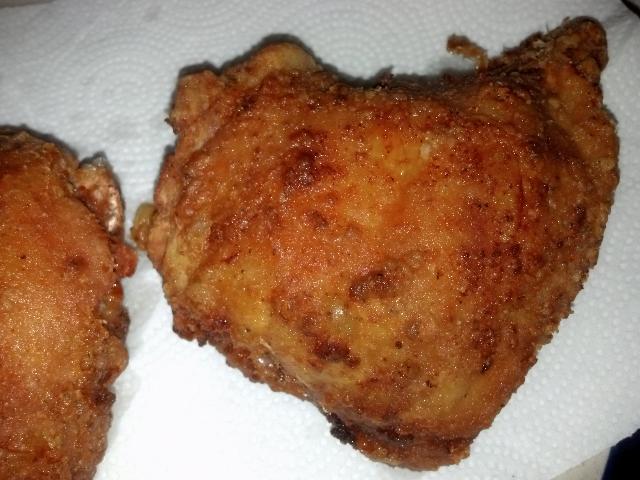
Conclusion: a deep-fryer is much more foolproof than cooking fried chicken in a skillet with a smaller amount of oil. It was cooked through and cooked evenly. It was much easier than the fried chicken I've made before. Will do again.
Each thigh was very large and averaged about 8 ounces, and with the flour and spices, cost $0.46. I would have gladly eaten several of them, but I ate one and I'm saving one for tomorrow. Or later tonight.
Lunch was an egg salad sandwich and the last of the Urad Dal. Since I had $0.45 left over, I had a late-night snack of a $0.25 frozen burrito. Daily total: $2.30.
| Item | Cost |
|---|---|
| Egg Salad Sandwich (prices are for 1 sandwich) | |
| 3/4 Egg | $0.04 |
| Mayonnaise, 15 g | $0.07 |
| 2 slices white bread | $0.12 |
| 1 sandwich subtotal | $0.23 |
| Urad Dal (3/8 cup prepared) | $0.12 |
| Potato Pea Soup | |
| Potatoes, 5.23 lb @ ($2.99/(10 lb)) | $1.57 |
| Bouillon, 30 g @ ($4.98/(35.3 oz)) | $0.15 |
| Green peas, 2.2 lb @ $2.49/(2 lb) | $2.74 |
| Milk, 110 floz | $2.36 |
| Butter, 1/2 lb @ $1.99/lb | $1.00 |
| Potato pea soup subtotal (23 cups) | $7.82 |
| Potato pea soup subtotal (1 cup) | $0.35 |
| Potato pea soup subtotal (3 cups) | $1.05 |
| Chicken thigh | $0.43 |
| Flour, spices | $0.03 |
| Chicken thigh subtotal | $0.46 |
| Tapioca Pudding | |
| 1/6 box pudding, Kroger house brand | $0.10 |
| 1/3 cup milk | $0.06 |
| Milk on pudding (36 g) | $0.03 |
| Pudding subtotal | $0.19 |
| Frozen burrito | $0.25 |
| Daily Total | $2.30 |
For lunch, I had a couple of extremely cheap hot dogs (Bar S Classic Bun Length Franks, $0.75 for 8) that I had bought on sale 2 weeks ago. Each hot dog was only $0.09, and I ate them on ordinary white bread instead of a bun, which made them quite cheap: only $0.15 apiece. Compare this to $0.48 for my previous hot dog plus bun! I could have 3 hot dogs for the price of 1, but only ate 2.
Dinner was more potato pea soup (3 bowls) and another piece of delicious fried chicken from yesterday.
When serving the potato pea soup from the refrigerator, there was a huge crust of butter that had solidified on top of the soup which had to be broken apart and carefully portioned into the soup. I got to thinking about ways to improve this, and decided I would do a little experiment with an emulsifier.
Emulsifiers help to prevent oil and water from separating. Look how the droplets of butter separate into large droplets in ordinary soup, within seconds of stirring:
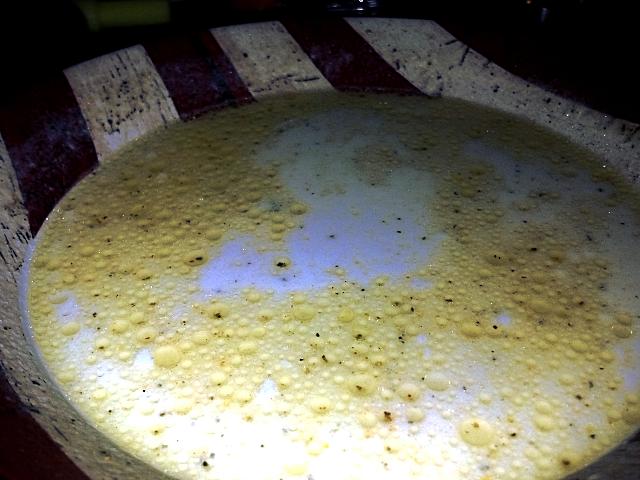
My mom and I made molecular gastronomy kits for several friends and family this Christmas, and I had an emulsifier, soy lecithin, in my kit. I added 1.2 g of soy lecithin to a bowl of soup (this is a concentration of 0.5% by mass, cost $0.05) and stirred it vigorously and heated it in the microwave. After re-stirring, this is what the soup looked like:
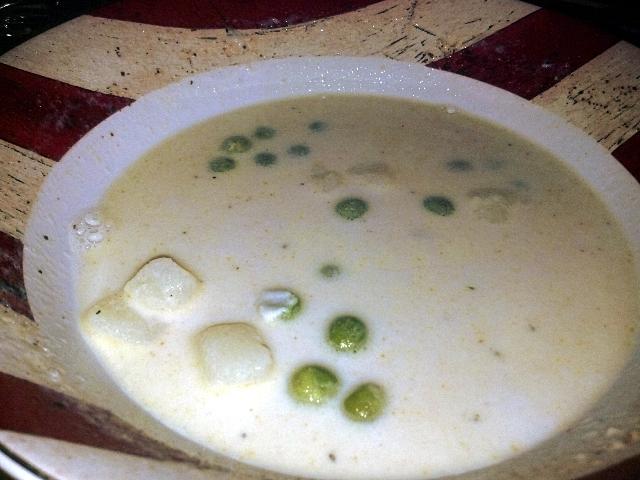
Note that the butter no longer separates into large droplets. The emulsifier helps disperse the butter more evenly into the soup. Would this make my soup easier to serve and more uniform? Since butter is less dense than milk, it will still try to float to the surface of the liquid, so it probably won't solve my refrigerator storage problem. But it's an interesting experiment nevertheless! I'll have to try adding some emulsifier to a batch of soup that I store in the fridge and see how well it prevents separation. A big problem is that mixing it vigorously (like with a stick blender) would also break up the potatoes and peas. If I'm going to add emulsifier, I'll have to add it to the hot milk and butter before adding the potatoes.
This was a very quick-and-dirty experiment, but it demonstrated that a little bit of soy lecithin will help keep fats from separating in soup. No difference in taste was detected. I tasted a small amount of the soy lecithin powder, and it didn't have a strong taste.
For a late-night snack, I also had some tapioca pudding and banana bread. Some of the banana bread had to be frozen because it's not getting eaten fast enough. Daily total: $2.27.
| Item | Cost |
|---|---|
| Cheap Hot Dogs (price per hot dog) | |
| 1 Hot Dog, Bar S @ (8 dogs/ $0.75) | $0.09 |
| White Bread, 1 slice | $0.06 |
| Completed hot dog (1) subtotal | $0.15 |
| 2 hot dog subtotal | $0.30 |
| Potato Pea Soup | |
| Potato pea soup subtotal (3 cups) | $1.05 |
| Soy lecithin, 1.2 g | $0.05 |
| Chicken thigh | $0.43 |
| Flour, spices | $0.03 |
| Chicken thigh subtotal | $0.46 |
| Tapioca Pudding | |
| 1/6 box pudding, Kroger house brand | $0.10 |
| 1/3 cup milk | $0.06 |
| Milk on pudding (36 g) | $0.03 |
| Pudding subtotal | $0.19 |
| Bonus banana bread | $0.16 |
| Butter, 7 g | $0.06 |
| Banana bread subtotal | $0.22 |
| Daily Total | $2.27 |
Lunch was, again, 2 cheap hot dogs on bread. Total cost: $0.30. Dinner was 2 bowls of potato pea soup (which is disappearing very rapidly!) for $0.70 and 2 cabbage rolls for $0.94. I was hungry, so for a late-night snack I had a bowl of rather ordinary ramen ($0.17) with some bok choy $(0.27) and an egg ($0.04).
I've avoided calculating the exact cost breakdown for the 61 cabbage rolls that I made before the experiment. Here it is:
| Item | Cost |
|---|---|
| Krautburgers (Cost for whole batch) | |
| Yeast, 4 packets | $1.99 |
| Milk, 4 1/3 cups | $0.81 |
| Sugar, 1/2 cup | $0.12 |
| Salt, 4 teaspoons | $0.02 |
| Flour, 13 cups | $2.08 |
| Egg yolks, 13 | $0.55 |
| Butter, 17 tablespoons | $2.00 |
| Breading subtotal | $7.57 |
| Ground Chuck, 80% lean, 4 lb @ $3.99/lb | $15.96 |
| Yellow onions, 4 | $1.78 |
| 2 heads cabbage, 4 lb @ $0.79/lb | $3.15 |
| 2 tablespoons vegetable oil, | $0.04 |
| Filling subtotal | $20.93 |
| 61 Krautburgers subtotal | $28.50 |
| 1 Krautburger subtotal | $0.47 |
Since I had been working on the estimate that each krautburger cost $0.41, this increases my costs somewhat on a few days! Luckily, I just went back and revised the totals for the 2 other days (day 2 and day 13) on which I had krautburgers, and was still well under the total on those days! Whew! I just stressed myself out there for a minute.
| Item | Cost |
|---|---|
| Cheap Hot Dogs (price per hot dog) | |
| 1 Hot Dog, Bar S @ (8 dogs/ $0.75) | $0.09 |
| White Bread, 1 slice | $0.06 |
| Completed hot dog (1) subtotal | $0.15 |
| 2 hot dog subtotal | $0.30 |
| Potato Pea Soup | |
| Potato pea soup subtotal (2 cups) | $0.70 |
| 2 Krautburgers subtotal | $0.94 |
| Not The World's Best Ramen | |
| Bok choy, 4.3 oz | $0.26 |
| 1 egg | $0.04 |
| Ramen (1 pkg) | $0.17 |
| Ramen subtotal: | $0.47 |
| Daily Total | $2.41 |
For lunch, I had 1.5 fried egg sandwiches and 1/2 of a lovely grapefruit that were on sale for $0.25.
Dinner was another piece of the salmon that I bought on day 3, prepared about the same way, along with a bowl of potato pea soup. I slightly overcooked the salmon in an attempt to get the skin crispy (and splashed hot oil on my hand in the process.)
I mentioned before that creating your own sourdough starter was a way to have an active culture of yeast available to make bread more inexpensively. I looked at a few sourdough recipes, and decided to try and adapt a non-sourdough recipe for Garlic Knots that I had seen. Take a look at the pictures in that recipe. It looks good.
I had recently created a sourdough starter, which I fed with a cup of flour and a cup of water about 12 hours in advance so it would be nice and active. The sourdough starter had some gentle bubbles in it, so I made a very simple pizza dough recipe, adapting the recipe from the garlic knots site. It was approximately 1 cup sourdough starter, 2.5 cups flour, 2 tablespoons sugar, 2 teaspoons salt, 1 fl.oz. olive oil, and water. Since I made the dough the night before, I followed the usual pizza dough advice and put it into the refrigerator overnight, and then warmed it the next day and tried to let it rise for about 5 hours.
In order to try and make it cheaper, and because I didn't have the ingredients on hand, I eliminated the pepperoni, cheese, even the onions. I used garlic powder, onion powder, and a few other spices like oregano. I also used vegetable oil instead of olive oil. Again, since I was using a sourdough starter, I didn't add any yeast.
Unfortunately, when I was ready to eat, the dough still hadn't risen appreciably. It had risen a little bit, but I was too impatient to wait another 5 hours or whatever, so I cooked it anyway.
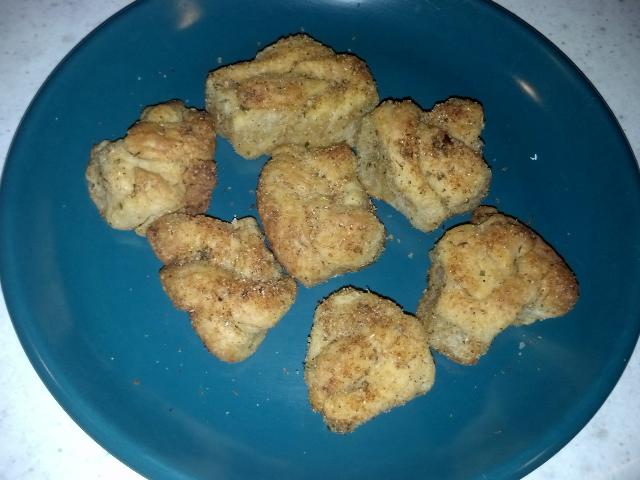
So...yeah. To make a long story short, the garlic knots didn't really rise, and were very dense. The taste was good, and they smelled amazing, but they were doughy inside and very solid outside. I made the mistake of putting them back into the oven to try and remove some of the doughiness inside, but it just made them harder.
What I learned was that I needed a more active sourdough starter, or a higher proportion of it. Putting the dough in the refrigerator overnight was probably a mistake too. Ah, well, it was a half-assed experiment. I'll try to do better next time.
I know that sourdough can make a gorgeous pizza dough; I made a batch about a year ago that was the most beautiful, perfect dough you've ever seen. I don't recall if I added additional yeast, though. I may have.
| Item | Cost |
|---|---|
| Fried Egg Sandwich (prices are for 1 sandwich) | |
| White bread, 2 slices | $0.12 |
| 1.6 eggs | $0.06 |
| Mayonnaise, 0.75 oz | $0.09 |
| 1 sandwich subtotal: | $0.17 |
| 1.5 sandwich subtotal: | $0.26 |
| 1/2 grapefruit | $0.13 |
| Salmon | |
| 6.25 oz salmon at $1.99/lb | $0.77 |
| Vegetable oil for cooking | $0.02 |
| 1/8 large lemon | $0.11 |
| Salmon subtotal: | $0.90 |
| Potato pea soup subtotal (1 cup) | $0.35 |
| Garlic Knots | |
| 3.5 cups flour | $0.42 |
| 1/4 cup vegetable oil | $0.08 |
| 2 tablespoons sugar | $0.03 |
| Spices (est) | $0.15 |
| Garlic knots subtotal: | $0.68 |
| 1/4 Garlic knots subtotal: | $0.17 |
| Daily Total | $1.81 |
I didn't eat breakfast or lunch due to the terrible life decision of purchasing Civilization V. Somehow I stayed up all night playing it.
Dinner was a quick Banquet turkey pot pie ($0.79), half a grapefruit ($0.13), and some Macaroni & White Cheddar that I got from a box (the whole box was only $0.25, Wild Harvest brand in-store promotion at Albertson's.) I also had a few of the Garlic Knots from the day before, which I tried to revive and soften by microwaving them in a wet paper towel. It didn't work.
Since dinner was so inexpensive, I had a large frozen burrito for a late-night snack. (El Monterey XX Large Bean & Cheese Burrito, 10 oz.) I bought a bunch of these last summer for cheap on an in-store closeout, (I'm thinking $0.50) but I don't remember exactly, so I'm going to call it $1.00, which is the everyday Walmart price. Daily total: $2.30.
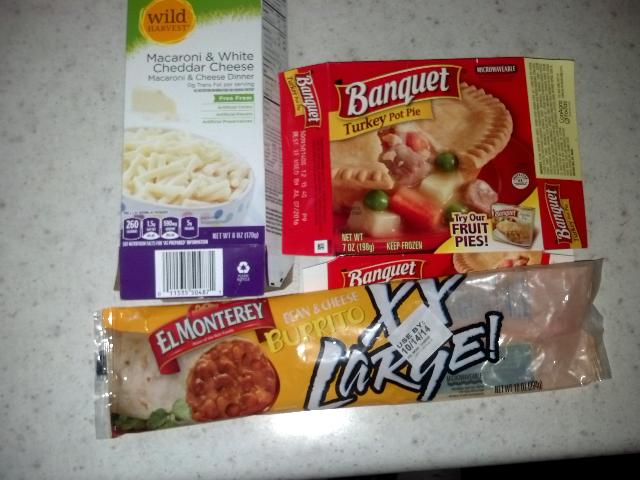
| Item | Cost |
|---|---|
| Banquet Turkey Pot Pie | $0.79 |
| 1/2 grapefruit | $0.13 |
| Macaroni & White Cheddar | |
| 1 Box Wild Harvest Mac & Cheese | $0.25 |
| 1/2 cup milk | $0.06 |
| 2 tablespoons butter | $0.12 |
| Mac & Cheese total batch subtotal: | $0.43 |
| 2/3 portion subtotal: | $0.29 |
| 1/8 Garlic knots subtotal: | $0.09 |
| El Monterey frozen burrito (overestimate): | $1.00 |
| Daily Total | $2.30 |
Since I had more beautiful, large, inexpensive chicken thighs ($0.88/lb) in the freezer, I decided to try my luck again with fried chicken.
I have always been afraid of making fried chicken. It's hard to cook it evenly. It's hard to make sure it's cooked through. It's hard not to burn it. It's hard not to spatter yourself with oil. It's hard to keep the crust on the chicken. However, I'm getting drastically more confident with cooking it now that I know how easy it is in a deep fryer instead of a skillet. It's also much easier to use just one very tolerant part of the chicken (thighs) so everything cooks evenly and at the same time. I passed the first chicken test on day 14, so it was time to take it a step further. To HOT CHICKEN!
Over the last year, I've seen more and more "hot chicken" on cooking shows. I've seen chefs who have had their lives changed by trying hot chicken. It's especially popular in Nashville, which even has a Hot Chicken Festival and Hot Chicken Coalition. I've never even tried hot chicken, and I'm not planning on going to Nashville any time soon, so I better try making my own.
What makes hot chicken hot? Well, according to most recipes, the chicken is seasoned and fried in more or less the usual manner, but after it's fried, it's always basted with a hot oil and spice mixture which contains unbelieveable amounts of cayenne pepper, along with other spices like garlic powder, chili powder, and usually a fair amount of brown sugar to make a glaze and temper the heat.
Many recipes insist that the hot oil actually has to be lard. I bought lard on day 11, so I was ready to go!
Most recipes also dredge the chicken in flour twice to get a thicker, crispier crust, dipping it in an egg-and-milk wash in between. This is the first time I've done a double-dredge. Here's the process for hot chicken!
For the spicy coating, I slowly heated 3.5 oz of lard with a frightening amount of spices. I used 2 tablespoons of cayenne pepper which is very intimidating to see being measured out. I also added about 2 teaspoons of garlic powder, 1 teaspoon of chili powder, some salt, and about 2-3 tablespoons of brown sugar. I let this warm slowly and for a long time so that the spices could bloom in the oil and impart their flavors to it. I believe that this tempered the heat of the cayenne pepper significantly. If I would have eaten that much raw cayenne pepper, it would have blown my head off. Instead, it developed a rich, smoky, complex flavor that was absolutely delicious. I think that the lard may have helped to add rich, meaty flavors here.
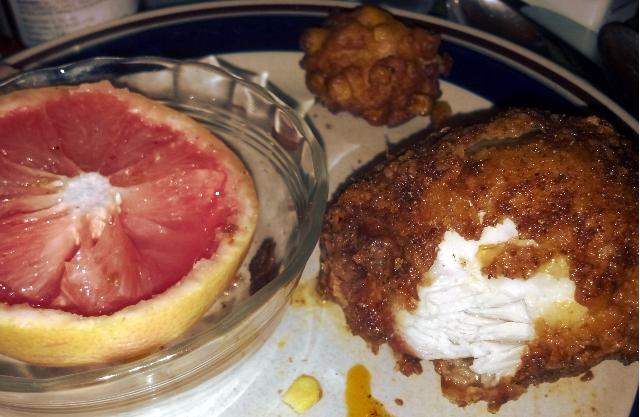
Look at that delicious crust. I brushed the first piece lightly with the hot oil, because I was afraid how hot it would be. It turned out that it was pleasantly hot, and the brown sugar in the glaze made it absolutely delicious. The second piece I brushed quite generously. Yum.
I simply can't overstate how good this was. I've made some very good chicken wings in my life. People have told me they were the best wings they've ever had. They've told me that they were the best chicken they've ever had. I've even had people tell me it was the best thing they've ever eaten. Once I literally had so many people rave about my wings that I had a vegetarian decide at that moment to go back to eating meat, and she did. This chicken is as good as any I've ever made, if not even better. It's already one of my favorite foods I've ever eaten. It is one of the best things I've ever eaten. I literally couldn't stop talking about it. The flavor was balanced and rich, spicy and sweet, the crust was crisp and the chicken was moist. And it was amazingly inexpensive and filling (the thighs averaged about 8 oz. before cooking.) Eating two pieces of chicken, I'd never guess for a second that I was trying to eat inexpensively. Wow. What a meal.
Not bad at all for a day I only spent $2.00 on food! Easily, a life-changing meal. I can see how professional chefs become obsessed with hot chicken and need to make it in their own restaurants!
(You may have noticed some other deep-fried treats in the background of that picture. Those are corn and potato fritters, which are also delicious. I'll write about them tomorrow, as I have more hot chicken to eat tomorrow!)
Breakfast was a big bowl of minute oatmeal ($0.22).
| Item | Cost |
|---|---|
| Oatmeal | |
| Oatmeal, 0.6 cup (uncooked volume) | $0.14 |
| Milk, 1/4 cup | $0.05 |
| Brown sugar, 1 tablespoon | $0.03 |
| Oatmeal subtotal: | $0.22 |
| Hot Chicken (prices are for 1 piece) | |
| 1 Chicken Thigh | $0.43 |
| 1/4 Egg | $0.01 |
| Milk, 2 floz | $0.03 |
| Flour | $0.03 |
| Spices (est.) | $0.10 |
| Lard | $0.06 |
| Hot Chicken Subtotal, 1 piece: | $0.66 |
| Hot Chicken Subtotal, 2 pieces: | $1.32 |
| Corn 'n Tater Fritters (1 batch) | |
| Hungry Jack Potato Pancake mix, 1 pouch | $0.63 |
| 1 can corn | $0.25 |
| 1/3 cup flour | $0.04 |
| 1/2 cup milk | $0.06 |
| Corn fritters subtotal: | $0.98 |
| Corn fritters 1/3 batch subtotal: | $0.33 |
| 1/2 grapefruit | $0.13 |
| Daily Total | $2.00 |
Breakfast/lunch was another big bowl of minute oatmeal ($0.22).
For dinner, I had more hot chicken! I saved one piece for today and slathered it heartily with the hot cayenne sauce. I did it right this time and served it on a piece of soft, store-bought white bread, and served it with some dill pickle. (My aunt's homemade dill pickles!)
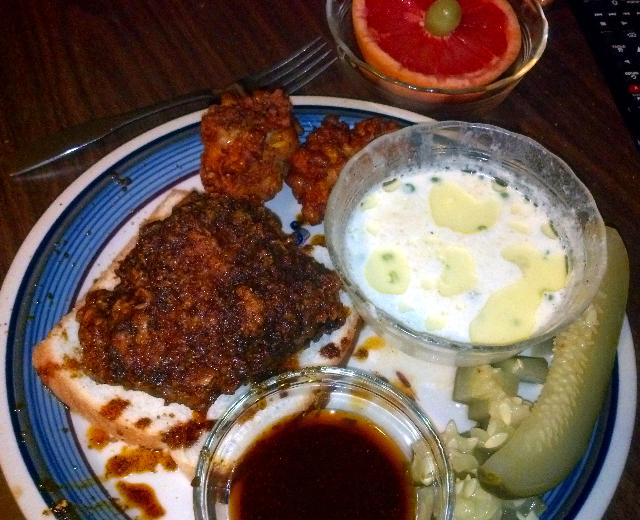
Look at that splattery, messy mess of good food! D for plating, A+ for flavor!
It was unbelievably good and the crust was still crisp, as I wrapped the chicken in paper towels to absorb moisture before refrigerating it, and reheated it long and slow in an oven at 225°F, increasing to 250°F because I didn't want to wait any longer.
I also had another grapefruit, the last of the potato pea soup, and a couple more corn and potato fritters! I promised to describe the potato-corn fritters yesterday. (You can see them at the top of the plate.) They're very simple. The recipe comes from the side of a box of Hungry Jack Potato Pancake mix:
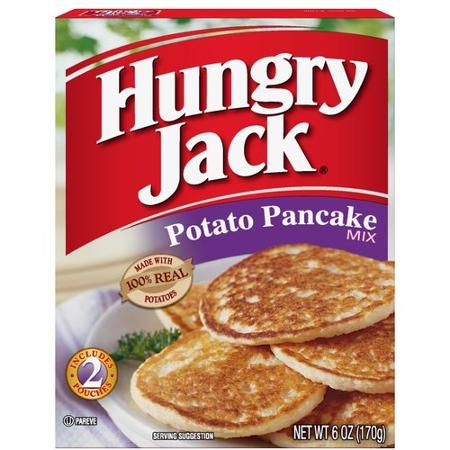
It's basically one pouch of potato pancake mix (there are 2 pouches per box) to which you add a can of corn (which I bought earlier for $0.25/can!) some flour, milk, and an egg. The potato pancake powder has baking soda for a leavener, so these make a very light airy batter that you then deep-fry for a few minutes. They're delicious and light but quite filling. The recipe is on the side of the box. Dip them in the spicy oil for the chicken (as seen at the bottom of the picture) and they're even better.
I have to repeat everything I said yesterday about how good the Hot Chicken was. It's absolutely delicious. I can't wait to have it again. You'll note in the picture that it's even redder today, as I brushed it heavily with the spicy coating. The bread absorbed some of the drippings and had a delicious flavor.
Since I was at only $1.70 for the day, I had a late-night snack of a peanut butter sandwich ($0.29). The thing that surprises and saddens me about that is that I could have had an egg salad sandwich or a fried egg sandwich even cheaper! Daily total: $1.99.
| Item | Cost |
|---|---|
| Oatmeal | |
| Oatmeal, 0.6 cup (uncooked volume) | $0.14 |
| Milk, 1/4 cup | $0.05 |
| Brown sugar, 1 tablespoon | $0.03 |
| Oatmeal subtotal: | $0.22 |
| Hot Chicken, 1 piece: | $0.66 |
| White bread, 1 piece: | $0.06 |
| Corn fritters 1/6 batch: | $0.17 |
| 1/2 grapefruit | $0.13 |
| Potato pea soup (5.5 oz) | $0.24 |
| Banana bread | $0.16 |
| Butter, 7 g | $0.06 |
| Banana bread subtotal | $0.22 |
| Peanut Butter Sandwich | |
| White bread, 2 slices | $0.12 |
| Peanut Butter (Jif), 31 g @ ($2.48/lb) | $0.17 |
| Peanut Butter Sandwich subtotal | $0.29 |
| Daily Total | $1.99 |
I've been missing potato chips, but if there's one thing I have a lot of, it's potatoes. And I have a deep fryer that has oil. I have some old potatoes that were sprouting, but those are great for chips, because they're already drying out and fry quickly. I didn't even bother peeling them.
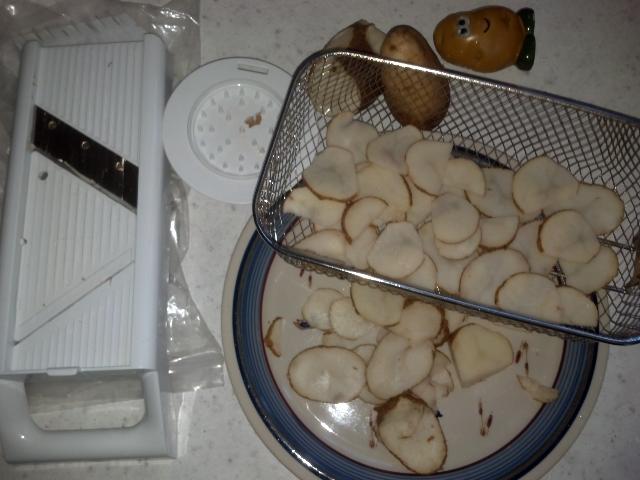
After a quick pass through the mandeline, the potatoes were ready for frying. Egg salad sandwich and fresh chips!
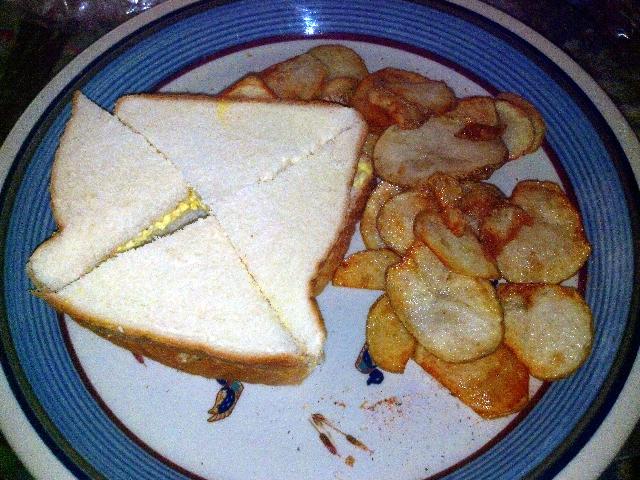
They were so good that I made some more. What made the chips even better was slicing them thicker and then sprinkling them with the barbecue rub I made on day 6. That was amazing!
Those two platefuls (about 8 oz of potatoes before cooking) cost about $0.16 total. Yes! I think the only thing that prevents people from eating french fries or chips with every meal is that they don't "keep" well. They're terrible cold and they don't reheat right in an oven or microwave.
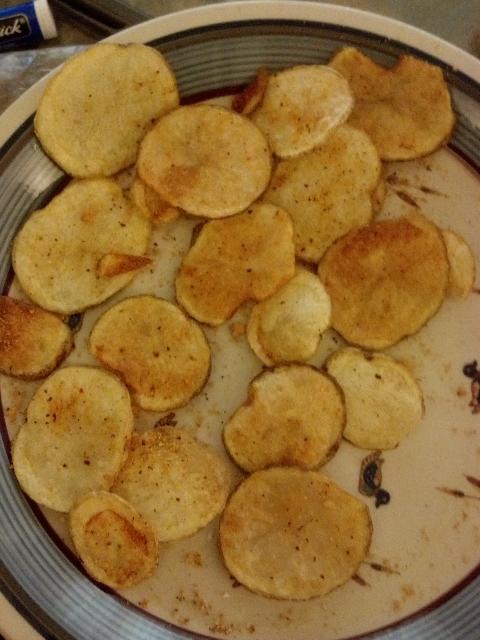
For dinner, I made a big pot of spaghetti. Well, rigatoni noodles, actually. I use the very simple recipe that I grew up with—just tomato sauce, tomato paste, and ground beef. (Along with garlic powder, salt, and black pepper.) It only takes about 30 minutes to make, will feed you for several days, and reheats in minutes. You can even use the sauce to make pizza. A big plate of pasta + sauce was $1.37. Daily total: $2.21.
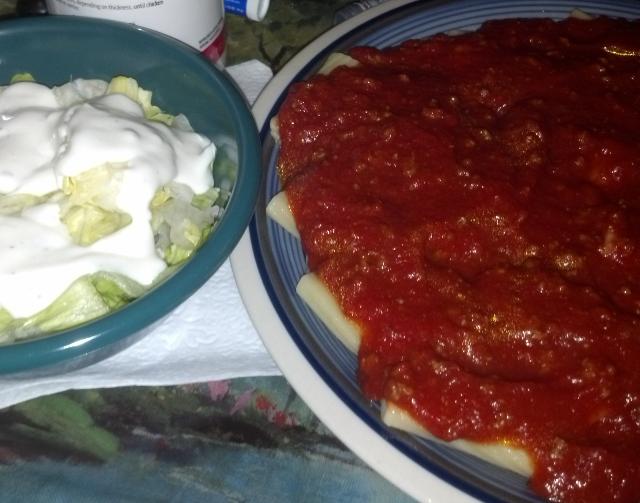
| Item | Cost |
|---|---|
| Egg Salad Sandwich (prices are for 1 sandwich) | |
| 3/4 Egg | $0.03 |
| Mayonnaise, 16 g | $0.07 |
| 2 slices white sandwich bread | $0.08 |
| 1 sandwich subtotal | $0.18 |
| Fried potato chips | $0.16 |
| Spaghetti Sauce | |
| Tomato Sauce, 6 15-oz cans @ $0.79/can | $4.74 |
| Tomato Paste, 2 12-oz cans @ $1.29/can | $2.58 |
| Ground beef, 85% lean, 1.21 lb @ $4.49/lb | $5.43 |
| Spaghetti sauce subtotal, 130 oz | $12.75 |
| Spaghetti sauce, 1 serving, 12 oz | $1.18 |
| Pasta | |
| Rigatoni, 1.5 pounds (dry) @ $0.89/lb, 59 oz cooked | $1.34 |
| Rigatoni, 8.5 oz cooked | $0.19 |
| Salad | |
| Lettuce, 1/11 head @ $0.99/head | $0.09 |
| Blue cheese dressing, Ken's 1.45 oz @ ($2.47/(16 oz)) | $0.22 |
| Salad subtotal | $0.31 |
| Bonus banana bread | $0.16 |
| Butter, 3.5 g | $0.03 |
| Daily Total | $2.21 |
Yesterday's food was so good that I did almost the exact the same thing today. Egg salad sandwich and potato chips for lunch. It was a great opportunity to use up more potatoes that look like this:

When you see dry old potatoes like that, think "perfect chips and fries!"
Dinner was once again a big plate of spaghetti and a salad. It only took a couple of minutes to reheat, which is why I like making a huge pot of spaghetti. Daily total: $2.21.
| Item | Cost |
|---|---|
| Egg Salad Sandwich (prices are for 1 sandwich) | |
| 3/4 Egg | $0.03 |
| Mayonnaise, 16 g | $0.07 |
| 2 slices white sandwich bread | $0.08 |
| 1 sandwich subtotal | $0.18 |
| Fried potato chips | $0.16 |
| Spaghetti Sauce | |
| Spaghetti sauce, 1 serving, 12 oz | $1.18 |
| Pasta | |
| Rigatoni, 8.5 oz cooked | $0.19 |
| Salad | |
| Lettuce, 1/11 head @ $0.99/head | $0.09 |
| Blue cheese dressing, Ken's 1.45 oz @ ($2.47/(16 oz)) | $0.22 |
| Salad subtotal | $0.31 |
| Bonus banana bread | $0.16 |
| Butter, 3.5 g | $0.03 |
| Daily Total | $2.21 |
Today's lunch was similar to previous lunches—a braunschweiger sandwich. Dinner was, once again, a big plate of spaghetti, a salad, and a piece of spicy bread.
What's spicy bread? I'm glad you asked. I just invented it. Instead of making garlic bread, I had saved a bit of the lard-and-cayenne-pepper coating from the Hot Chicken I had made on day 19. Instead of buttering my bread, I just warmed a bit of the hot coating and brushed it on the bread, and put it under the broiler for a couple of minutes. Wow, was that delicious! It's definitely spicy, but it goes great with spaghetti. It would also go well with cheeses.
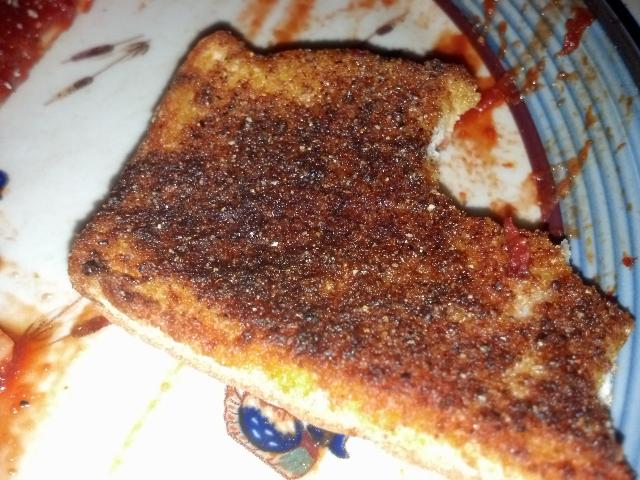
Later that evening, I had a hard-boiled egg ($0.04) and a piece of bread ($0.04). Daily total: $2.24.
I haven't really been tracking the amount of energy in the food I've been eating. I should try harder. How is that energy measured? Well, in the U.S., it's usually measured in Calories, and in most of the rest of the world, it's measured in kilojoules. A food Calorie is equal to exactly 4.1868 kilojoules.
Warning: There are two different units of measure that basically have the name "calories!" When you're talking about food, the word "Calorie" should be capitalized. This is because there happen to be two different calories: one as used by physicists, (and spelled with a small "c") and the one used in food packaging, which a physicist would call a "kilocalorie," and is spelled with a capital C. A food Calorie is 1000 of a physicist's "calories". Ugh. Don't get them confused in calculations.
How is the amount of energy in a certain piece of food calculated? That has to be pretty difficult.
In the U.S., the "Nutrition Labeling and Education Act" of 1990 requires that the energy Calories of packaged food is calculated primarily from the energy-containing components of the food: protein, carbohydrate, fat and alcohol.
These labels use the Atwater system, which establishes the following energy densities, in Calories/gram, of those four ingredients:
| Item | Calories/gram |
|---|---|
| Protein | 4 |
| Carbohydrate | 4 |
| Alcohol | 7 |
| Fat | 9 |
This allows simple calculation/estimation of the energy content of food without complicated experiments (like burning the food in a bomb calorimeter.)
The trouble is determining what percentage of what is in any given food, of course.
The U.S. Department of Agriculture's Nutrient Data Laboratory Web site provides the "USDA National Nutrient Database for Standard Reference" which contains detailed nutritional information on over 8,600 foods. You can even search the National Nutrient Database online, or download the database for your own use.
You can use my calculating tool and programming language Frink to calculate the energy content in food. You first define the energy content:
protein = 4 Calories/gram
carbohydrate = 4 Calories/gram
fat = 9 Calories/gram
Then, to find how much energy a pound of these contains, you just say something like:
1 pound protein -> Calories
Which gives you 1814 Calories. Again, note that in Frink we use
Calories with a capital "C" for the food Calorie, which
should not be confused with the physicist's lowercase
calorie. Frink knows about both. You can also write
kilocalorie or kcal or just use
kilojoules or kJ (note that capitalization is
correct and required.)
So, if you had one pound of each of the following, here's approximately how many Calories it would give you, according to the Atwater system:
| 1 pound protein | 1800 Calories |
| 1 pound carbohydrate | 1800 Calories |
| 1 pound fat | 4100 Calories |
| 1 pound alcohol | 3200 Calories |
| Item | Cost |
|---|---|
| Braunschweiger sandwich | |
| Braunschweiger (Kroger house brand), 2 oz @ 2.50/lb | $0.31 |
| White bread, 2 slices | $0.08 |
| Lettuce | $0.03 |
| Braunschweiger sandwich subtotal: | $0.44 |
| Spaghetti Sauce | |
| Spaghetti sauce, 1 serving, 12 oz | $1.18 |
| Pasta | |
| Rigatoni, 8.5 oz cooked | $0.19 |
| Salad | |
| Lettuce, 1/11 head @ $0.99/head | $0.09 |
| Blue cheese dressing, Ken's 1.45 oz @ ($2.47/(16 oz)) | $0.22 |
| Salad subtotal | $0.31 |
| Hard-boiled egg | $0.04 |
| White bread, 2 slices | $0.08 |
| Daily Total | $2.24 |
Breakfast/lunch was fried eggs (or is it a skull?) and fried potatoes. That's only half of the fried potatoes.
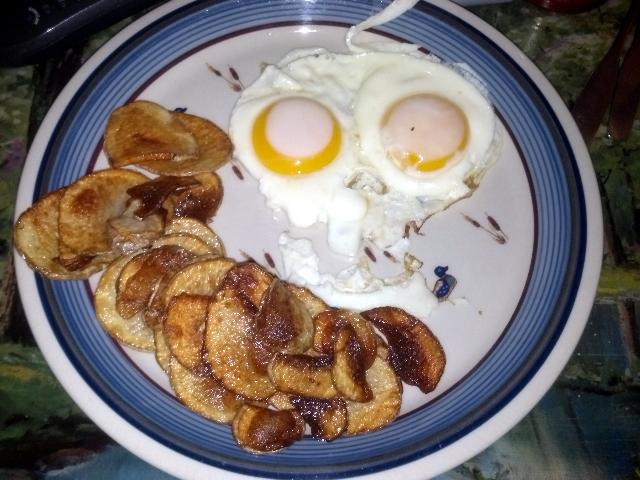
Dinner was the last of the salmon that I bought on day 3 and a big bowl of ramen with bok choy. I added some of my barbecue rub to the ramen to give it more flavor. The salmon was pan-fried with a bit of flour for crispy skin.
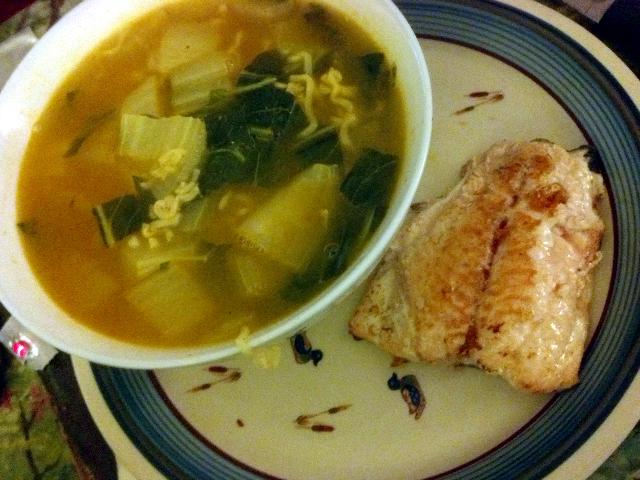
| Item | Cost |
|---|---|
| 2 Fried Eggs | $0.14 |
| Fried potato chips | $0.18 |
| Salmon | |
| 6.25 oz salmon at $1.99/lb | $0.77 |
| 1/8 large lemon | $0.11 |
| Salmon subtotal: | $0.88 |
| Big Ramen | |
| Bok choy, 4.8 oz | $0.29 |
| Ramen (1 pkg) | $0.20 |
| Spices | $0.13 |
| Ramen subtotal: | $0.62 |
| Bonus banana bread | $0.10 |
| Butter, 3.5 g | $0.03 |
| Daily Total | $1.95 |
Breakfast was a quick bowl of quick oatmeal.
Lunch and dinner was a bit of a potluck with friends and relatives, so according to my "don't burden others" rule, I didn't really limit my expenditures. Nevertheless, I had several foods that were on sale due to St. Patrick's Day: Corned beef brisket and cabbage. I also made rye bread with caraway seeds.
Corned beef was $3.00/lb, which is about as cheap as you're likely to get beef. It's not really my favorite, as there's some taste in cured meats that I don't really like. (Nitrites? Saltpeter?) However, if you cook it correctly (low and slow in a slow cooker) with enough spices it can be pretty good.
The night before, I chopped 2 medium onions ($0.50) and put them in the bottom of the slow cooker on low. I covered the beef with some of my barbecue rub like I made on Day 6. I then put the brisket into the slow cooker and covered it with water, and added more rub to taste. I then left it to cook overnight (for about 10 hours).
The next morning, I made some easy cabbage with a whole head of cabbage (at $0.29/pound, a big head of cabbage cost only $1.07,) two cans of diced tomatoes ($0.50 each) and some more barbecue rub in the pressure cooker. After the pressure cooker started rattling, I cooked it for 7 minutes. This made a good side dish, if you like cooked cabbage.

The rye bread was good too. It used a tablespoon of caraway seeds, which are surprisingly expensive. (The last batch I saw at the grocery store was about $6.50 for a ~1.5-oz bottle!) As I knew people like my rye bread, I didn't skimp. I wouldn't use caraway seeds otherwise.
I have to admit that I ate quite a bit of the beef at the potluck. And the fat. And bread. And potato chips. I had been very hungry in the morning, so it was welcome. Daily cost: exempt.
| Item | Cost |
|---|---|
| Oatmeal | |
| Oatmeal, 0.6 cup (uncooked volume) | $0.14 |
| Milk, 1/4 cup | $0.05 |
| Brown sugar, 1 tablespoon | $0.03 |
| Oatmeal subtotal: | $0.22 |
| Daily Total | Exempt |
Only one meal today: a big plate of leftover spaghetti and rye bread. I made the rye bread into spicy bread like I made on day 23. More spaghetti is on the way.
| Item | Cost |
|---|---|
| Spaghetti Sauce | |
| Spaghetti sauce, 1 serving, 14 oz | $1.37 |
| Pasta | |
| Rigatoni, 8.5 oz cooked | $0.19 |
| Rye bread | |
| 1 piece (est) | $0.15 |
| Daily Total | $1.71 |
For lunch, I had some corned beef and cabbage leftover from the potluck on day 25. Since these are leftovers from a shared potluck, I didn't try to track it too carefully, but estimated about 6 oz of corned beef at $3.00/lb, for a cost of $0.94.
For dinner, I had some more leftovers: spaghetti and rye bread. With the leftover corned beef, I was slightly over my budget at $2.61. I didn't want the corned beef to go to waste, and since it was leftover from a potluck, I think of it as "free food."
| Item | Cost |
|---|---|
| Corned beef, 5 oz | $0.94 |
| Cooked cabbage | $0.15 |
| Spaghetti Sauce | |
| Spaghetti sauce, 1 serving, 12 oz | $1.18 |
| Pasta | |
| Rigatoni, 8.5 oz cooked | $0.19 |
| Rye bread | |
| 1 piece (est) | $0.15 |
| Daily Total | $2.61 |
Only one meal today: a big plate of leftover spaghetti, rye bread, and a salad (the lettuce is going downhill rapidly.) I made the rye bread into spicy bread like I made on day 23. The spaghetti is almost gone, but not quite. Maybe the reports will get interesting again when I have to think about food again. It's been so easy just to reheat a plate of spaghetti that I haven't thought about food much.
| Item | Cost |
|---|---|
| Spaghetti Sauce | |
| Spaghetti sauce, 1 serving, 14 oz | $1.37 |
| Pasta | |
| Rigatoni, 8.5 oz cooked | $0.19 |
| Salad | |
| Lettuce, 1/11 head @ $0.99/head | $0.09 |
| Blue cheese dressing, Ken's 1.45 oz @ ($2.47/(16 oz)) | $0.22 |
| Salad subtotal | $0.31 |
| Rye bread | |
| 1 piece (est) | $0.15 |
| Daily Total | $2.02 |
Only one major meal today: the last of the corned beef, some cabbage, and fried potatoes. I like them french-fried potaters, mmmhm. Later that night I had a piece of cake left over from another potluck event. Total: $1.67
| Item | Cost |
|---|---|
| Corned beef, 5 oz | $0.94 |
| Cooked cabbage | $0.15 |
| Fried potato chips | $0.18 |
| Cake | $0.40 |
| Daily Total | $1.67 |
For breakfast, I just fried a bunch more of them French-fried potaters, mmmhm.
For dinner, I had a big plate of the last of the spaghetti, along with a salad and some more spicy bread. The big pot of spaghetti went a long way, and is literally one of the easiest things to make and reheat.
| Item | Cost |
|---|---|
| Spaghetti Sauce | |
| Spaghetti sauce, 1 serving, 14 oz | $1.37 |
| Pasta | |
| Rigatoni, 8.5 oz cooked | $0.19 |
| Salad | |
| Lettuce, 1/11 head @ $0.99/head | $0.09 |
| Blue cheese dressing, Ken's 1.45 oz @ ($2.47/(16 oz)) | $0.22 |
| Salad subtotal | $0.31 |
| Rye bread | |
| 1 piece (est) | $0.15 |
| Daily Total | $2.02 |
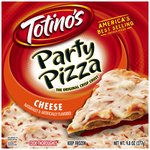 I skipped breakfast/lunch and a Totino's Party Pizza (cheese) sounded
really good, so I threw one of them in the oven for an early dinner.
I skipped breakfast/lunch and a Totino's Party Pizza (cheese) sounded
really good, so I threw one of them in the oven for an early dinner.
The modern world is really pretty amazing. I don't know how you can make and package and distribute a delicious pizza in a shiny box for $1.25. They're still one of my favorites, you can find them anywhere, and you can't beat the price. (Especially when your grocery store puts them on sale for less than a dollar.)
I remember doing an experiment with my family when I was very young; we cooked 3 different types of pizzas, and decided which we liked the best. I remember vividly that the pizzas we tried were Totino's, Jeno's, and John's. (I haven't seen John's for a long time, but I occasionally see Jeno's. The spices in Jeno's sauce are really good, but I like Totino's super-thin crust better.) For years, we'd eat pizza on Sunday nights (mostly Totino's) and watch TV. (I even remember that we watched a Wonderful World of Disney while we did the experiment.) There probably hasn't been any significant length of time in the past 25 years that I haven't had a couple of Totino's pizzas in my freezer, and I probably eat one a week. (I am not paid by Totino's in any way, but if they want to send me free pizzas for life and stuff, they totally should.)
Late that evening, I was hungry again so I made 2 quick fried egg sandwiches. The pan was a bit hot so it almost instantly flash-burned the lower layer eggs to the pan. Grr.
Diatribe: As an engineer, don't get me started on the stupidity of any open-loop "control system". Like a stove burner. A proper "closed-loop" control system has a sensor so you know, say, how hot your actual surface is, and can control its temperature, rather than just pumping a constant level of power into a heating element or a gas burner. That is literally the worst way to control a system. I know that professional chefs like gas burners because they rapidly respond to control inputs, but in other ways they're the worst possible system because they always pump the same amount of power into your dish, regardless of what temperature you want to hit. The human has to be the constant control system but with no actual data on, say, what the surface temperature of the pan is. A real control system should let you specify what temperature you want to hit, and should hold that for you. I've built my own temperature controller, which, given enough time to learn, controls any electrical system to within about 0.1°F, which I hope to write about in this experiment. See more below.
 Even later, I was still hungry so I took a bit of the leftover rigatoni and
made one of my favorite 1-minute dishes with it: Mae Ploy noodles.
Even later, I was still hungry so I took a bit of the leftover rigatoni and
made one of my favorite 1-minute dishes with it: Mae Ploy noodles.
If you don't know of Mae Ploy Sweet Chilli Sauce, you need to know about it. It's a chef's secret weapon. (I have a hard time typing "chilli" with two "L"s, but that's the way it's written on the label, so I'm going with it.) It's usually just called "Mae Ploy" by chefs, even though the Mae Ploy company makes many other products. You will find it in all good grocery stores, and you will often find it, often incredibly cheap, at the front of good Asian markets. In fact, many good Asian markets will have big bottles of Sriracha sauce, big bottles of Mae Ploy Sweet Chilli sauce, and big bags of rice stacked in front, inexpensively, on pallets. It is assumed that you will want all of these things. For better prices than you'll find anywhere else. Stock up. Their wisdom is correct.
Mae Ploy noodles are simply:
You just throw that in the microwave for about a minute (depending on how cold your initial ingredients are, it may be half that) and it's delicious.
Mae Ploy is awesome on many foods, including pizza crusts, chicken, pasta, fried egg sandwiches, toasted cheese sandwiches (although Sriracha is even better,) cooked potatoes, meats, shrimp (especially with butter and Sriracha sauce) and more. It's not too hot, it's not too sweet, it's just perfectly balanced. (And as an amateur gardener who grows primarily tomatoes and peppers, I can't imagine how hard/expensive it is to grow enough peppers for a single bottle.) This is not the cheapest ingredient per ounce if you don't find a good supplier, so be careful. (As you can see below, I (probably overestimated) 2 floz for my dish, which at Walmart's prices, costs $0.39.)
Simple pasta recipes are so easy that the New York Times declared a rather
simple (but with expensive ingredients like Parmigiano-Reggiano cheese)
recipe for Pasta with Fried Lemons and Chili Flakes as their most-popular recipe of the year. (I haven't made it, but friends have and say it's great.)
| Item | Cost |
|---|---|
| Totino's Party Pizza | $1.25 |
| Fried Egg Sandwich (prices are for 1 sandwich) | |
| White bread, 2 slices | $0.10 |
| 1.5 eggs | $0.06 |
| Mayonnaise, 0.75 oz | $0.09 |
| 1 sandwich subtotal: | $0.25 |
| 2 sandwich subtotal: | $0.50 |
| Pasta w/Mae Ploy | |
| Rigatoni, 8.5 oz cooked | $0.19 |
| Mae Ploy Sweet Chilli Sauce, 2 oz (est.) @ ($1.96/(10 floz)) | $0.39 |
| Butter, 2 tablespoons | $0.12 |
| Mae Ploy Noodles subtotal: | $0.70 |
| Daily Total | $2.45 |
I happened to be watching an episode of Simply Ming in which he and one of his guest chefs cooks several dishes with offal. Offal are the parts of an animal that aren't skeletal muscles, such as liver or kidneys. (It's also called "organ meats" or "variety meats" or "giblets" in poultry.) I remembered that I had a tub of chicken livers (20 oz, $1.69) in the freezer, so my task was to try and cook them in an interesting way.
You may or may not like liver. It definitely has a strong, distinct flavor. If you like it, it's a filling and iron-rich treat. I've always liked it, if it's prepared and cooked correctly. The chicken livers I have were about $1.35/lb so they aren't cheaper than many chicken parts. If you happen to come across liver on sale, it can be rather economical.
First, I soaked the livers in milk. This is a "traditional" method for reducing some of the stronger tastes of the liver. I don't know if it actually works better than some other liquid (such as water or brine) but some blood did come out into the milk. I then rinsed the livers in water and drained them well.
The best liver I ever made was during this experiment last year; I heavily seasoned some cow's liver and coated them in panko breadcrumbs (these are a crisp Japanese type of breadcrumbs) mixed with seasoning and fried in a skillet. The crispness of the breading complemented the softness of the liver, and made it easier to eat a lot. So I decided to try a crispy coating this time.

I do have some panko breadcrumbs in my cupboard, but I also had an old box of Corn Flakes (part of a Christmas present from over a year ago,) which I wanted to try to use as a coating. My mom used to make chicken coated with Corn Flakes, but I never could get them to stick during frying. I decided to adapt the recipe for Hot Chicken that I made on day 19. The only difference was that the final dredge was in crushed Corn Flakes instead of flour.
I was worried that cooking liver in my deep-fryer would leave flavors in the oil, (which I want to keep using) so I decided to cook them in a skillet instead.
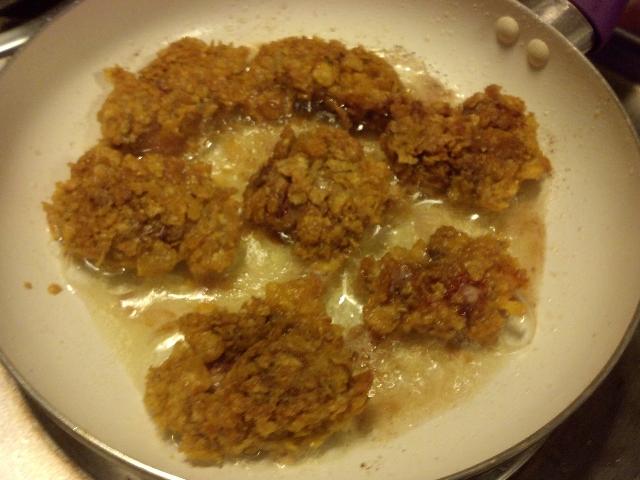
(The cooking process reminded me of why I don't like trying to cook fried chicken in a skillet. Oil spatters everywhere, it's hard to control temperature, the food cooks unevenly and burns on the bottom, and it's a lot harder to clean up.)
After taking them out, I brushed the livers with the Hot Chicken sauce like I made on day 19.
The livers were quite good! They had no smell, but they did taste like liver! The crunch of the Corn Flakes was nice, and the spicy sauce was delicious. I ate a lot of them (but not even all of the 10 oz that I cooked,) and was quite satisfied. Due to the difficulty of preparation and cleanup, though, I'll probably choose a simpler recipe for cooking the rest of the livers. I also cooked a couple of potato chips. The liver was so filling that I only ate about 6 ounces of the 10 ounces I prepared.
For a late snack, I made some more Mae Ploy noodles like I described yesterday.
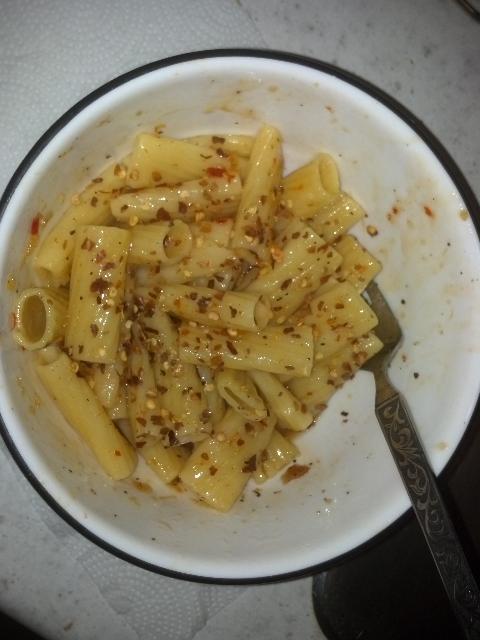
The red pepper flakes came with a pizza that I had some time in the past. Daily total: $1.50.
| Item | Cost |
|---|---|
| Chicken Livers (price for 10 oz) | |
| Chicken Livers, (10 oz @ $1.69/(20 oz)) | $0.84 |
| 1 Egg | $0.08 |
| Milk, 2 floz | $0.03 |
| Flour | $0.03 |
| Spices (est.) | $0.10 |
| Lard | $0.06 |
| 10 oz subtotal | $1.14 |
| 6 oz subtotal | $0.68 |
| Fried Potatoes | |
| Potatoes, ~4 oz | $0.10 |
| Vegetable oil | $0.02 |
| Potatoes subtotal | $0.12 |
| Pasta w/Mae Ploy | |
| Rigatoni, 8.5 oz cooked | $0.19 |
| Mae Ploy Sweet Chilli Sauce, 2.6 floz @ ($1.96/(10 floz)) | $0.49 |
| Butter, 2 tablespoons | $0.12 |
| Mae Ploy Noodles subtotal: | $0.70 |
| Daily Total | $1.50 |
Since I had some cooked chicken livers left over from yesterday, I had them and some more inexpensive macaroni and cheese for dinner. (I got it at $0.25/box earlier). Later, I had a big bowl of oatmeal.
Since I was still at only $1.02 for the day, I made myself a dang quesadilla (shredded cheese microwaved on a flour tortilla) and had 3.8 ounces of the big summer sausage I got for the amazing price of $1.00 for 21 ounces. Daily total: $1.41. Liver is quite filling and satisfying!
| Item | Cost |
|---|---|
| Chicken Livers (price for 10 oz) | |
| Chicken Livers, (10 oz @ $1.69/(20 oz)) | $0.84 |
| 1 Egg | $0.08 |
| Milk, 2 floz | $0.03 |
| Flour | $0.03 |
| Spices (est.) | $0.10 |
| Lard | $0.06 |
| 10 oz subtotal | $1.14 |
| 4 oz subtotal | $0.45 |
| Macaroni & White Cheddar | |
| 1 Box Wild Harvest Mac & Cheese | $0.25 |
| 1/2 cup milk | $0.06 |
| 2 tablespoons butter | $0.12 |
| Mac & Cheese total batch subtotal: | $0.43 |
| 2/3 portion subtotal: | $0.29 |
| Oatmeal | |
| Oatmeal, 0.57 cup (uncooked volume) | $0.14 |
| Milk, 1/4 cup | $0.05 |
| Brown sugar, 3 tablespoon | $0.09 |
| Oatmeal subtotal: | $0.28 |
| Quesadilla | |
| Flour tortilla | $0.08 |
| Cheese, shredded, 20 g @ ($2.88/lb) | $0.13 |
| Quesadilla subtotal: | $0.21 |
| Summer sausage, 3.8 oz @ $1.00/(21 oz) | $0.18 |
| Daily Total | $1.41 |
I still had chicken livers left over (20 ounces goes a long way!) so I decided to finish them off and try to simplify my spicy liver recipe a bit. (I'm not using my own kitchen for most of the next week or two, so I have limited ingredients and utensils.) There were 3 or 4 parts that caused a hassle, created a mess, added cost, and added time. I removed these from the list:
Instead, I just rinsed the livers in water, put some black pepper on them, dunked them in a mixture of 1 egg and 2 floz of milk, dredged them in some panko bread crumbs, and put them immediately into a frying pan with a bit of oil. (Again, panko are a Japanese style of bread crumbs which are light but crisp.)
These came out quite nice. The recipe was much simpler, and they were my favorite so far.
Oh, I didn't mention that I dipped each nugget into some of the hot chicken sauce from day 19! That made them amazing. Cooking the livers a bit longer reduced a bit of the liver flavor. Simply rinsing in cold water worked just as well as soaking in milk. The best liver I've made so far. Panko bread crumbs are great; they added a nice crispness and were very simple. I had Kikkoman brand on hand, which are great. See below for the price difference between panko and Corn Flakes.
I ate somewhere around 10 oz (probably a bit less) of livers and was quite satisfied.
Later, I made a batch of rice in the slow cooker. The largest batch it could accommodate was about 1.5 cups of rice and 3 cups of water. It takes about 2 hours for the rice to get done at this altitude and with that slow cooker. Since I didn't bring butter or spices with me, I had to compromise. I had a bit of the spicy lard sauce that I used for the livers left over, so I added about a tablespoon of that to the batch. It was enough to give the rice a bit of flavor. Daily total, $1.67.
| Item | Cost, cents per ounce |
|---|---|
| Kellogg's Corn Flakes, 12 oz box | 21.0 |
| Kellogg's Corn Flakes, 18 oz box | 16.3 |
| Kellogg's Corn Flakes, 24 oz box | 15.3 |
| Great Value Corn Flakes, 18 oz box | 11.0 |
| Great Value Panko, 8 oz box | 16.0 |
| Kikkoman Panko, 8 oz box | 18.5 |
| Dynasty Panko, 8 oz box | 25.0 |
| Progresso Panko, 8 oz box | 28.5 |
| Kellogg's Corn Flakes Crumbs, 21 oz box | 18.9 |
Did you notice that last entry? When I was looking up prices, I saw that you can get Kellogg's Corn Flake Crumbs already crushed up. If you want to go the Corn Flake route, they're not much more expensive than crushing up your whole Corn Flakes.
I haven't tried the Great Value brand Panko (and I didn't notice them at the store.) I like the Kikkoman brand a lot. It's good to know that it's not significantly more expensive than using Kellogg's Corn Flakes.
| Item | Cost |
|---|---|
| Chicken Livers (price for 10 oz) | |
| Chicken Livers, (10 oz @ $1.69/(20 oz)) | $0.84 |
| 1 Egg | $0.08 |
| Milk, 2 floz | $0.03 |
| Spices (est.) | $0.10 |
| Panko, Kikkoman brand, ~1.5 oz | $0.28 |
| Lard | $0.06 |
| 10 oz subtotal | $1.39 |
| 1 small banana @ $0.54/lb | $0.16 |
| Rice, 1.5 cups raw | $0.36 |
| Rice, prepared | $0.12 |
| Daily Total | $1.67 |
For breakfast, I had a small banana ($0.16). Lunch was 2 tuna sandwiches ($0.85) and a bowl of ramen with bok choy ($0.40).
I had a Banquet Chicken Fried Chicken frozen dinner (with mashed potatoes and corn.) It was okay, and for $0.75, I can't complain. (I got these a few weeks before at Albertson's for a "buy 10 items for $0.75" promotion. I also had 1/2 of a grapefruit ($0.21) and some more of the rice I cooked the night before ($0.12). Daily total: $2.49.
| Item | Cost |
|---|---|
| Banquet Chicken Fried Chicken meal | $0.75 |
| Ramen with Bok Choy | |
| Ramen | $0.20 |
| Bok choy, 3.2 oz | $0.20 |
| Soup subtotal | $0.40 |
| Rice | $0.12 |
| 1 small banana @ $0.54/lb | $0.16 |
| 2 Tuna Sandwiches | |
| 4 slices white bread | $0.23 |
| Tuna, 1/2 can | $0.38 |
| Mayonnaise, 2 oz | $0.24 |
| 2 Sandwiches subtotal | $0.85 |
| 1/2 grapefruit | $0.21 |
| Daily Total | $2.49 |
I had a quick lunch of 2 tuna sandwiches ($0.85). I also had a big glass of Squirt soda. ($0.21)
Since I had been craving a hamburger, I had a cabbage roll for dinner (see day 2) for $0.47. I'll say it again that making a huge batch of these was a great idea. I also had 2.4 ounces of cottage cheese, 1/2 grapefruit, and a half portion of rice.
Since I was only at $1.99 for the day, I had a late-night snack of two cheap hot dogs on white bread for a cost of $0.30. Oh, and a bit of kimchi. Daily total: $2.41.
| Item | Cost |
|---|---|
| 2 Tuna Sandwiches | |
| 4 slices white bread | $0.23 |
| Tuna, 1/2 can | $0.38 |
| Mayonnaise, 2 oz | $0.24 |
| 2 Sandwiches subtotal | $0.85 |
| Squirt, 16 floz @ ($0.88/(2 liters)) | $0.21 |
| 1 Cabbage Roll | $0.47 |
| Cottage Cheese, 2.4 oz @ ($1.25/lb) | $0.19 |
| Rice | $0.06 |
| 1/2 grapefruit | $0.21 |
| Cheap Hot Dogs (price per hot dog) | |
| 1 Hot Dog, Bar S @ (8 dogs/ $0.75) | $0.09 |
| White Bread, 1 slice | $0.06 |
| Completed hot dog (1) subtotal | $0.15 |
| 2 hot dog subtotal | $0.30 |
| Homemade Kimchi | $0.12 |
| Daily Total | $2.41 |
For breakfast, I had a quick banana.
I wanted to make something that would last for several days, so I made a gigantic batch of split pea soup. Like more than 3 gallons of it! Split pea soup is one of my favorite soups. Unfortunately, I didn't find split peas on sale (they were actually quite expensive most places I've seen in the past month) but Walmart had them for $1.37/lb.
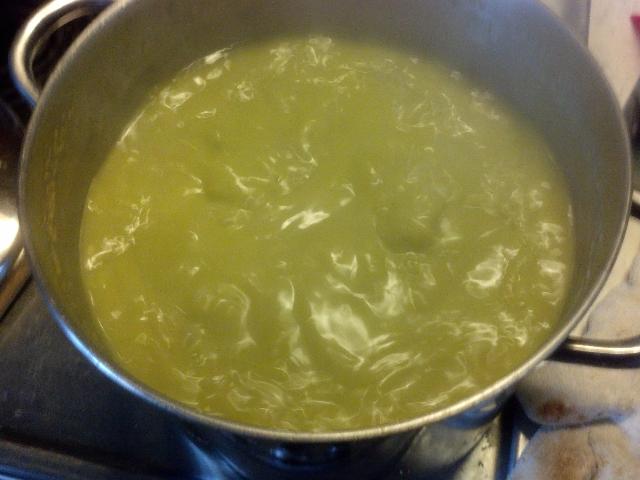
Here is the basic ingredient list for a gigantic pot of split pea soup. (The recipe actually comes from the back of a package of Hurst's HamPeas.) I didn't use their peas, (sorry, guys) but they come with a little packet of artificial ham flavor. You will need a huge stockpot.
Bring the water to a boil, and add the rest of the ingredients, cover, and boil until the peas are broken down. (Your boiling time will be different than mine as I live at an altitude of over 5600 feet, so water boils at the lower temperature of 204°F (95°C), and boiling dry beans and peas and pasta takes significantly longer.) You will need to boil it for at least an hour. For me, it takes at least an hour and a half. Stir frequently.
Tip and Warning 1: Based on a suggestion from the people at Cook's Illustrated, baking soda can help reduce cooking times for beans and lentils by helping to break down the skins. I added the baking soda early in the process, and it immediately started to make the soup foam, which progressively got worse until it boiled over and I had to lift it off the heat. Ugh. I too-late tried the home-beer-brewer's trick of spraying the foam with a sprayer bottle of water, but the foam was too active and I was too late. Be prepared for boilover. Luckily, after the protein foam boils off or is skimmed off, you're okay for the rest of the boil.
Tip and Warning 2: Keep stirring! And keep boiling! While the recipe on the HamPeas bag tells you to reduce the heat and simmer after 30 minutes, I have found that unless you keep up the convection of an actively rolling boil, your soup tends to stick to the bottom of the pan and burn. I burned a giant batch of this soup last year while doing this experiment. That was not fun. (I'll note that adding some peanut butter to the soup reduced the burnt flavor.)
The whole enormous batch of split pea soup (and believe me, it is enormous,) cost about $9.07 for about 53 cups. That's a price of $0.17/cup. I ate 3 cups with dinner, and then, when trying to find enough space to store it all, ate 2 more cups.
To go along with the soup for dinner, I made some simple fish tacos. The cheapest fish that I saw was a bag of frozen Whiting, for about $2.80/lb. While the soup was cooking, I cooked the fish in a glass dish with some oil, vinegar, water, and spices in a toaster oven at 300°F (150°C). It took about 20 minutes. The texture of the fish was nice, but it really smelled and tasted fishy! Some of the fishiest fish I've ever had.
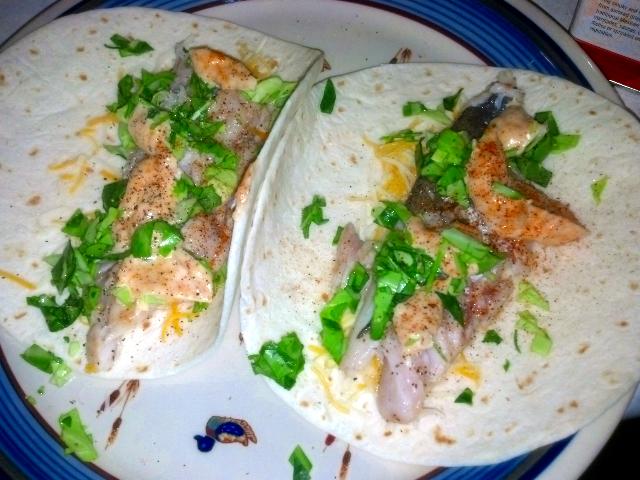
I also made a mayonnaise-based sauce to go on the fish tacos. This was mayonnaise, a bit of citric acid powder (to make it taste lemony without watering it down too much,) garlic powder, paprika, chili powder, and salt. This was a quite nice sauce which hid most of the fishy taste.
I didn't brine the fish or remove skin first; this may have helped to reduce fishy taste.
The tacos also had a small bit of cheese and some cabbage. The cost of 2 tacos was $0.85, with $0.65 of that being due to the fish.
Oh, and there was also a batch of brownies! A box of brownie mix was $0.99.
| Item | Cost |
|---|---|
| 1 small banana @ $0.54/lb | $0.16 |
| o | |
| Split Pea Soup, ~12 quart batch | |
| Carrots, 6.55 oz | $0.30 |
| 3 Onions, 16.60 oz | $0.92 |
| Dry Split Peas, 5 lb | $6.85 |
| Butter, 1/2 lb | $1.00 |
| Full batch subtotal, approx 53 cups | $9.07 |
| 1 cup subtotal | $0.17 |
| 5 cup subtotal | $0.85 |
| Fish Tacos, 2 tacos | |
| Fish, Whiting 3.7 oz @ ($6.99 / (40 oz)) | $0.65 |
| Cabbage | $0.02 |
| 0.5 oz cheese at $2.88/lb | $0.09 |
| 2 6" flour tortilla | $0.15 |
| Mayonnaise, 0.75 oz | $0.09 |
| 2 taco subtotal | $1.00 |
| Brownies, 1 batch | |
| Brownie Mix, Pillsbury Chocolate Fudge | $0.99 |
| Oil, vegetable, 2/3 cup | $0.24 |
| 2 Eggs | $0.16 |
| Brownie 1 batch subtotal | $1.39 |
| Brownie, 1/15 batch subtotal | $0.09 |
| Squirt, 16 floz @ ($0.88/(2 liters)) | $0.21 |
| Daily Total | $2.31 |
For breakfast, I had a huge bowl of oatmeal. Monkey oatmeal!
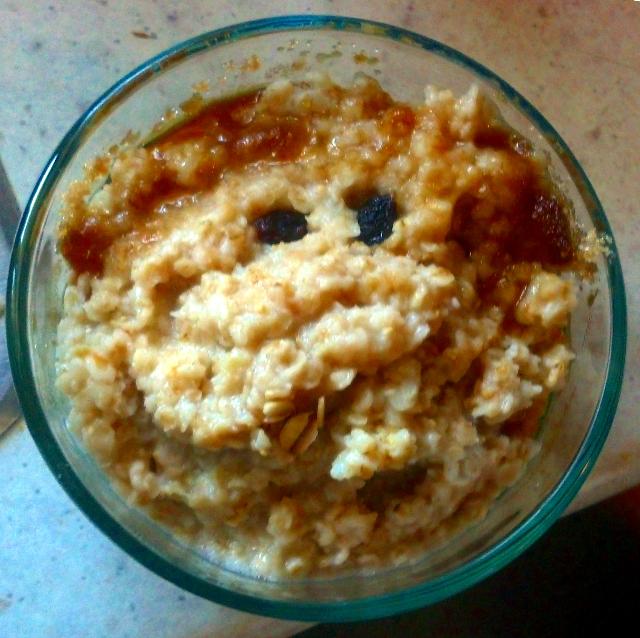
However, the big excitement for the day was that I had some incredibly cheap chicken thighs that I was going to fry for real buttermilk fried chicken!
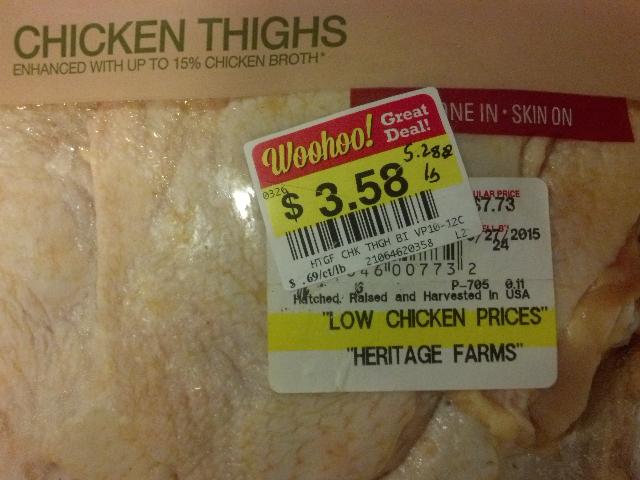
Woohoo! Expired meats! Okay, they weren't expired at all, but rather put on even deeper discount because the "sell by" date was the next day. The price was $3.58 for almost 5.3 pounds of chicken thighs; this is $0.68 / lb, the cheapest meat I've found so far! And that includes bologna or hot dogs! That's only $0.36 per thigh.
Surprisingly, I was walking by the dairy case and there was a carton of buttermilk that was similarly discounted; $1.10 for a quart of buttermilk. (It usually costs at least twice that.) So, for the first time in my life, I decided to make real buttermilk fried chicken. 7 of the 10 pieces of chicken went into buttermilk in the refrigerator overnight. I also added a good amount of salt to the marinade.
A book that I recently bought, and I really like, The Science of Good Cooking, found that it was necessary to use buttermilk and a large amount of salt when marinating for fried chicken. The lactic acid in the buttermilk helps to tenderize the meat, and the salty liquid acts as a brine to add moisture to the meat.
I seasoned the meat with a bit of my spice rub and then dredged it in flour with 1.5 teaspoons of baking powder. The baking powder produces gases in the hot oil, which will make the breading light and crunchy. I let the flour sit on the chicken for 5 minutes to get sticky and gummy, and then back into the buttermilk and back into the flour.
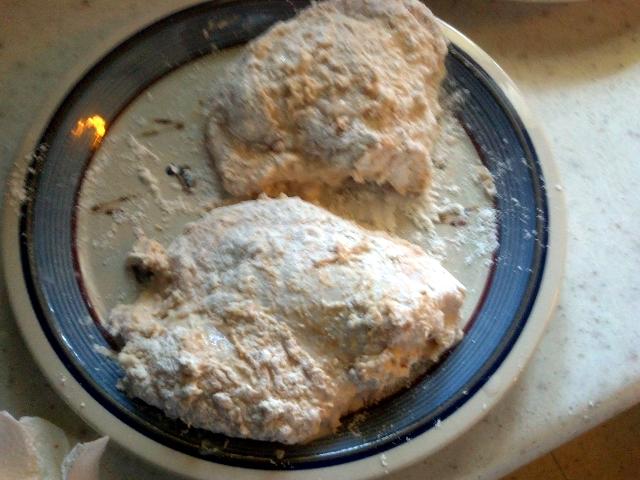
Then, into the deep fryer at 325°F (160 °C) for 20 minutes.
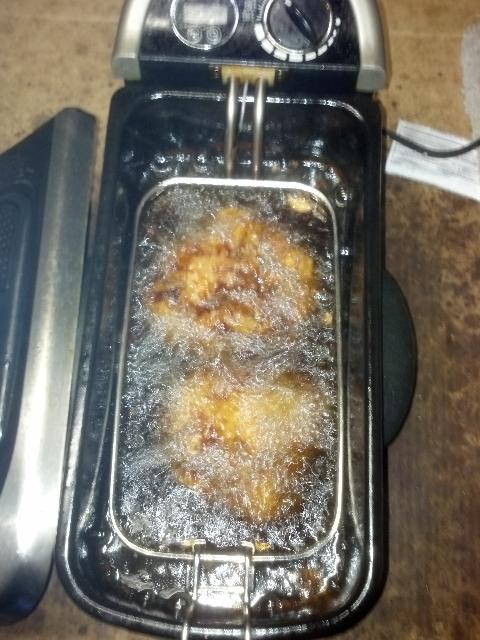
The chicken came out quite a bit darker than the chicken that I cooked the other day. I could have had the thermostat set a little higher. The other option is that I added a bit more oil to the deep fryer. Perhaps the larger volume kept the temperature from dropping as much when the chicken was added. I also refrained from doing the double dredge for the last pieces, as the breading was huge on the first few pieces.
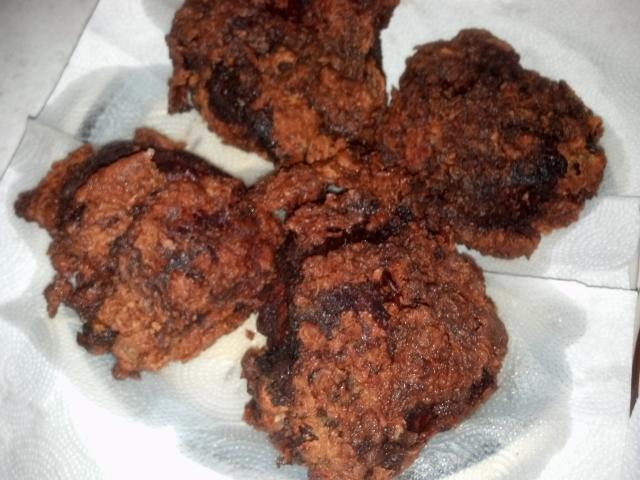
The tragedy of this whole story is that, because it's a Friday during Lent, I chose not to eat the chicken that day! However, since I'm not going to in my own kitchen for a while, I have lots of good chicken to eat! Instead, for dinner, I had two cups of split pea soup and a small frozen bean and cheese burrito. I also had a couple of brownies that a friend gave to me.
| Item | Cost |
|---|---|
| Oatmeal | |
| Oatmeal, 0.6 cup (uncooked volume) | $0.14 |
| Milk, 1/4 cup | $0.05 |
| Brown sugar, 1 tablespoon | $0.03 |
| Oatmeal subtotal: | $0.22 |
| Split Pea soup, 2 cups | $0.34 |
| Frozen burrito | $0.25 |
| Daily Total | $0.81 |
For lunch I finally had a piece of the fried chicken (cold.) It was quite good! It probably cooked a bit too long, as the breading had a bit of an overcooked taste. Overall, good, though! I could have used a bit more seasoning in the flour itself. I forgot to put salt in the flour.
I also had a piece of bread and a couple (free) brownies.
Overall, though, I was saving space for all-you-can-eat sushi that night. That was a social event so, according to my rules, I won't count it. I expected that I would eat two tons of sushi, but I guess my stomach has shrunk and I only ate one ton.
| Item | Cost |
|---|---|
| Fried Chicken (prices are for 1 piece) | |
| 1 Chicken Thigh | $0.36 |
| Flour | $0.03 |
| Spices (est.) | $0.03 |
| Buttermilk | $0.10 |
| Fried chicken subtotal | $0.52 |
| White bread, 1 slice | $0.06 |
| Daily Total (excluding sushi) | $0.58 |
For lunch, I had a bologna sandwich (the first I've had in about 30 years). I have to say that it wasn't great. It was cheap ($1.00/lb) but, geez, the fried chicken that I made was even cheaper than that. With a bit of planning, I could do much better. I didn't have any lettuce or cabbage or horseradish or cheese. It was just white bread, bologna, mayonnaise, and mustard. It wasn't very tasty. The split pea soup was good, though!
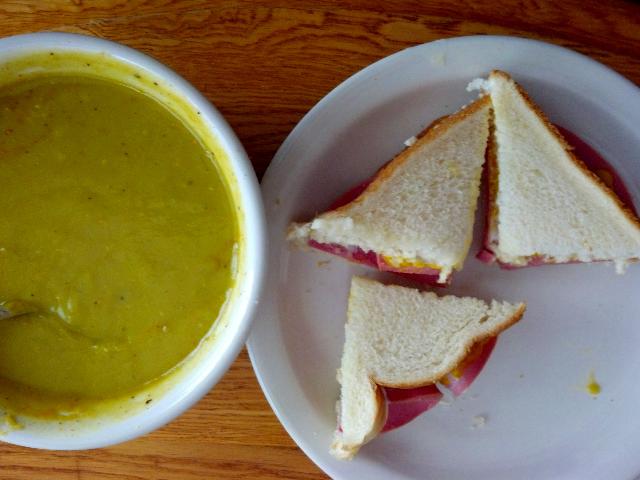
I am now ready to admit that I definitely overcooked the breading on the chicken. I actually picked some of it off and didn't eat it. And crispy chicken skin is one of my favorite things in the world. Nothing makes me feel like I've failed like overcooking and ruining good food. I'm still surprised that the chicken I cooked on day 14 and day 19 was cooked at supposedly the same temperature and for the same amount of time, but was cooked properly. I'm still trying to figure that one out. Next time, I won't rely primarily on a timer, but watch the chicken more carefully.
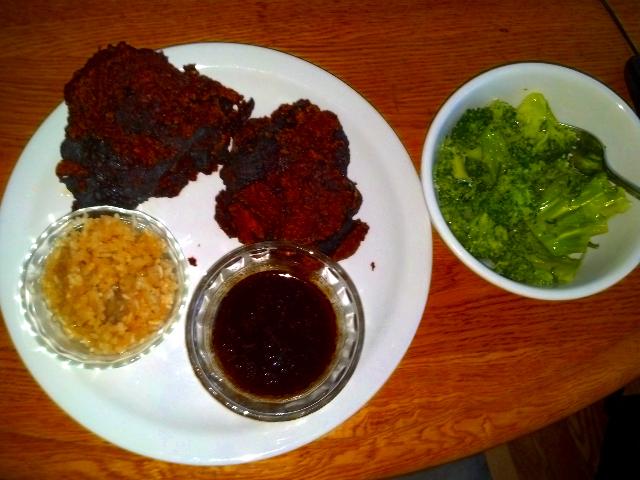
That evening, I had another bowl of split pea soup. It's good at any temperature!
| Item | Cost |
|---|---|
| Bologna sandwich | |
| White bread, 2 slices | $0.12 |
| 2 slices bologna @ ($1.00/(13 slices)) | $0.15 |
| Mayonnaise, 0.75 oz | $0.09 |
| 1 sandwich subtotal: | $0.36 |
| Fried chicken, 2 pieces | $1.04 |
| Broccoli, ~6 oz @ $1.00/lb | $0.37 |
| Split Pea soup, 3 cups | $0.51 |
| Rice, prepared | $0.06 |
| Daily Total | $2.34 |
I skipped breakfast and lunch, but had two pieces of my dark fried chicken and broccoli for dinner. Those are big pieces of chicken!
Later, I had a big bowl of split pea soup. It's an easy, quick meal!
| Item | Cost |
|---|---|
| Fried chicken, 2 pieces | $1.04 |
| Broccoli, ~5 oz @ $1.00/lb | $0.31 |
| Split Pea soup, 2 cups | $0.34 |
| Daily Total | $1.69 |
I looked at my cheap leftover ingredients which included: chicken thighs, potatoes, canned tomatoes, and buttermilk. So I decided to make chicken tikka masala! I bought all of these ingredients on deep discounts, so it should be very cost-effective!
Do you eat a lot of chicken tikka masala? Do you see it a lot? It is literally the most popular restaurant dish in the U.K.
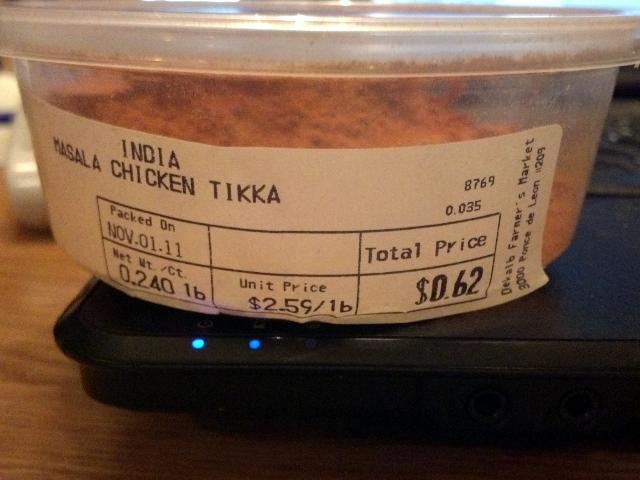
I've had a quarter-pound tub of pre-mixed tikka masala spices that I bought about 3 years ago when visiting the amazing Dekalb Farmer's Market in Decatur, Georgia. (Thanks for taking me, Ann!). The whole tub of spices only cost $0.62, which is an incredible deal (especially when you compare it to a jar of premixed tikka masala sauce, which is expensive.) I ended up using about 1/3 of the tub.
I peeled, diced, and boiled 4 small potatoes (approx 1 lb.) While the potatoes were boiling, I fried 3 chicken thighs in a pan with some oil, then boned them when they were just barely cooked, and finished cooking them through in the pan. I also cut and fried an onion.
Tikka masala is usually made with yogurt, but I had cheap buttermilk that smelled great, so I decided to use that instead. I also put in two cans of diced tomatoes that I had bought for $0.50/can. As it cooked, I spooned in spoonful after spoonful of tikka masala spices until the level of spice was right. I also thought it needed some acid, so I added about an ounce of lemon juice (from a bottle.) It wasn't quite as creamy as I'd like, so I found the end of a tub of Greek yogurt (Great Value brand, ~3 oz) and added that.
I then added the cooked, drained potatoes, fried onion, and the cooked chicken to the pot and let it just simmer for a few minutes. (You don't want to overcook the chicken. Chicken thighs are cooked right at around 161°F (72°C). It also needed a bit of salt. I also added the oil from cooking the chicken to the pot for a bit of richness (and calories, and not wasting food.)
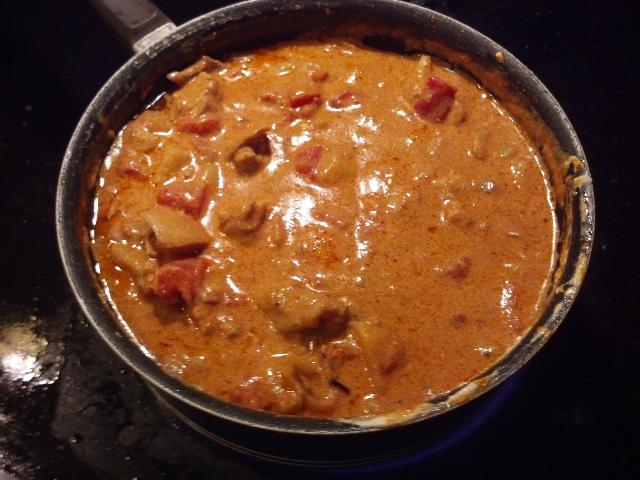
That's a big pot of Tikka Masala! Probably about 3 quarts. And very inexpensive. The whole pot cost about $3.83, and I probably only ate about 1/4 of it.
I had also made some rice in the crock pot. I let it go too long as it was very mushy. But you gotta serve tikka masala on rice!
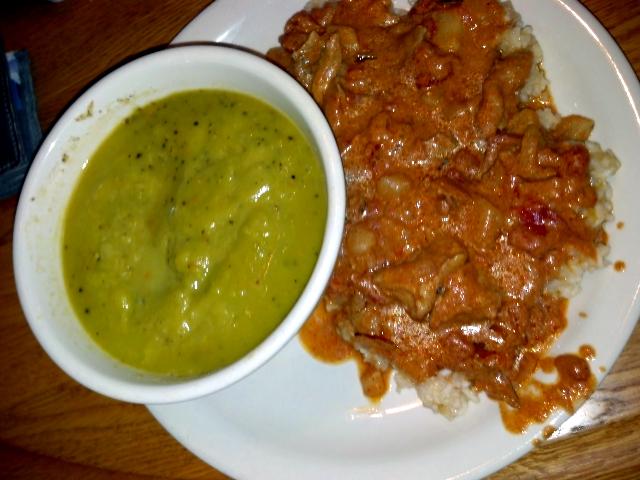
The tikka masala came out great! The spice mix was very nice and I'm glad I finally got to use it (after 3 years.) I probably only ate about 1/4 of the tikka masala, which should last about 3 or 4 meals! A great combination of inexpensive ingredients came together to make a great meal. Lots of protein, lots of flavor, lots of complexity. A great deal, too! It might even last me through the end of this experiment (although I generally don't like chicken after about 3 days.)
I ate two big servings of the chicken tikka masala, rice, and a bowl of split pea soup. I also had a free brownie. Late that night, I had a cheap ($0.25) frozen burrito.
Daily total: $1.52
| Item | Cost |
|---|---|
| Tikka Masala (1 batch) | |
| Chicken thighs, 3 pieces | $1.08 |
| Potatoes, 1 lb @ $0.30/lb | $0.30 |
| 1 medium onion | $0.25 |
| Tikka Masala Spices | $0.30 |
| Buttermilk, 1/3 quart | $0.37 |
| Greek Yogurt, (Great Value brand, 3 oz) | $0.40 |
| Lemon juice, 1 oz | $0.08 |
| Diced tomatoes, 2 cans (14.5 oz, $0.50 each) | $1.00 |
| Oil | $0.05 |
| 1 pot subtotal | $3.83 |
| 1/4 pot subtotal | $0.96 |
| Rice | $0.06 |
| Split Pea soup, 1.5 cups | $0.25 |
| Frozen burrito | $0.25 |
| Daily Total | $1.52 |
Well, since I still had a ton of chicken tikka masala, rice, and split pea soup, that became dinner. Later that night I had Second Dinner, which was more tikka masala. I still have a lot of tikka masala left over.
I believe I overestimated how much tikka masala that I eat with each meal, so I may go back and change my estimates. I'm not in my own kitchen, so I don't have a scale to easily measure. It goes a long way.
| Item | Cost |
|---|---|
| Tikka Masala, ~1/4 pot subtotal | $0.96 |
| Rice | $0.06 |
| Split Pea soup, 2 cups | $0.37 |
| Daily Total | $1.39 |
I still have a lot of chicken tikka masala and rice, so that was a quick lunch. Today I ate the last of the split pea soup.
Although I have chicken tikka masala left over, frankly, I was getting tired of it, so I had a Totino's Party Pizza for dinner.
| Item | Cost |
|---|---|
| Tikka Masala, ~1/4 pot subtotal | $0.96 |
| Rice | $0.06 |
| Split Pea soup, 1 cup | $0.17 |
| Totino's Party Pizza | $1.25 |
| Daily Total | $2.44 |
Since it's Good Friday, I chose not to eat the chicken tikka masala, but grabbed some quick fish sticks. It's been a long time since I've had fish sticks. I chose the package that had the most mass per dollar, which was Van De Kamp's crunchy fish sticks.
The fish sticks were good enough, but not very cost-effective. 11 very small fish sticks was exactly 1/4 of the box, (about 6 ounces) and they didn't fill me up very much. Those 11 fish sticks cost $1.25. Not a very smart purchase, but I was hungry and in a hurry. I should have followed my first instinct and made tuna fish sandwiches. I considered making fish sandwiches or fish tacos out of these, but, again, I'm not at home and don't have the ingredients on hand to make a proper sauce, so I just did something quick. They were not on a good sale, either.
I also had an ordinary bowl of shrimp-flavored ramen. Nothing too exciting.
Later that evening, I had the last of my broccoli with a bit of cheese (which was an indulgence.) I have no idea how much the cheese cost so I made an estimate of $7.00/lb. I could only do this because I was still well under budget for the day. Cheese is expensive.
| Item | Cost |
|---|---|
| Fish sticks, 11 Van de Kamp's @ ($5.00/(44 sticks)) | $1.25 |
| Ramen | $0.20 |
| Broccoli | |
| Broccoli, ~4 oz @ $1.00/lb | $0.25 |
| Cheese, ~1 oz @ $7.00/lb? | $0.44 |
| Broccoli subtotal | $0.69 |
| Daily Total | $2.14 |
For the last day of the experiment, I skipped breakfast and lunch, and had a simple dinner of fishsticks, urad dal, and half of a grapefruit. The urad dal (see Day 9) was cooked with a bit of bouillon powder (and I got it a bit too salty.) It wasn't as good as the batch that I cooked in leftover pork broth.
I also made some quick sauce for the fishsticks with a bit of ketchup and horseradish.
| Item | Cost |
|---|---|
| Fish sticks, 9 Van de Kamp's @ ($5.00/(44 sticks)) | $1.02 |
| Urad Dal ~2 oz of dry @ $3.99/(2 lb) | $0.25 |
| 1/2 grapefruit | $0.21 |
| Ketchup & Horseradish (est.) | $0.15 |
| Daily Total | $1.63 |
(Also, did you know that when you buy "country-style pork ribs" that they're usually just pork shoulder cut into rib-like shapes? I bought an electric smoker at a garage sale for $12.50 and I use it to smoke pork shoulder "ribs".)
Thanks for reading this. I hope I helped someone find a new food that they love, and can share with others. I will be adding to this page as I discover new inexpensive, amazing recipes.